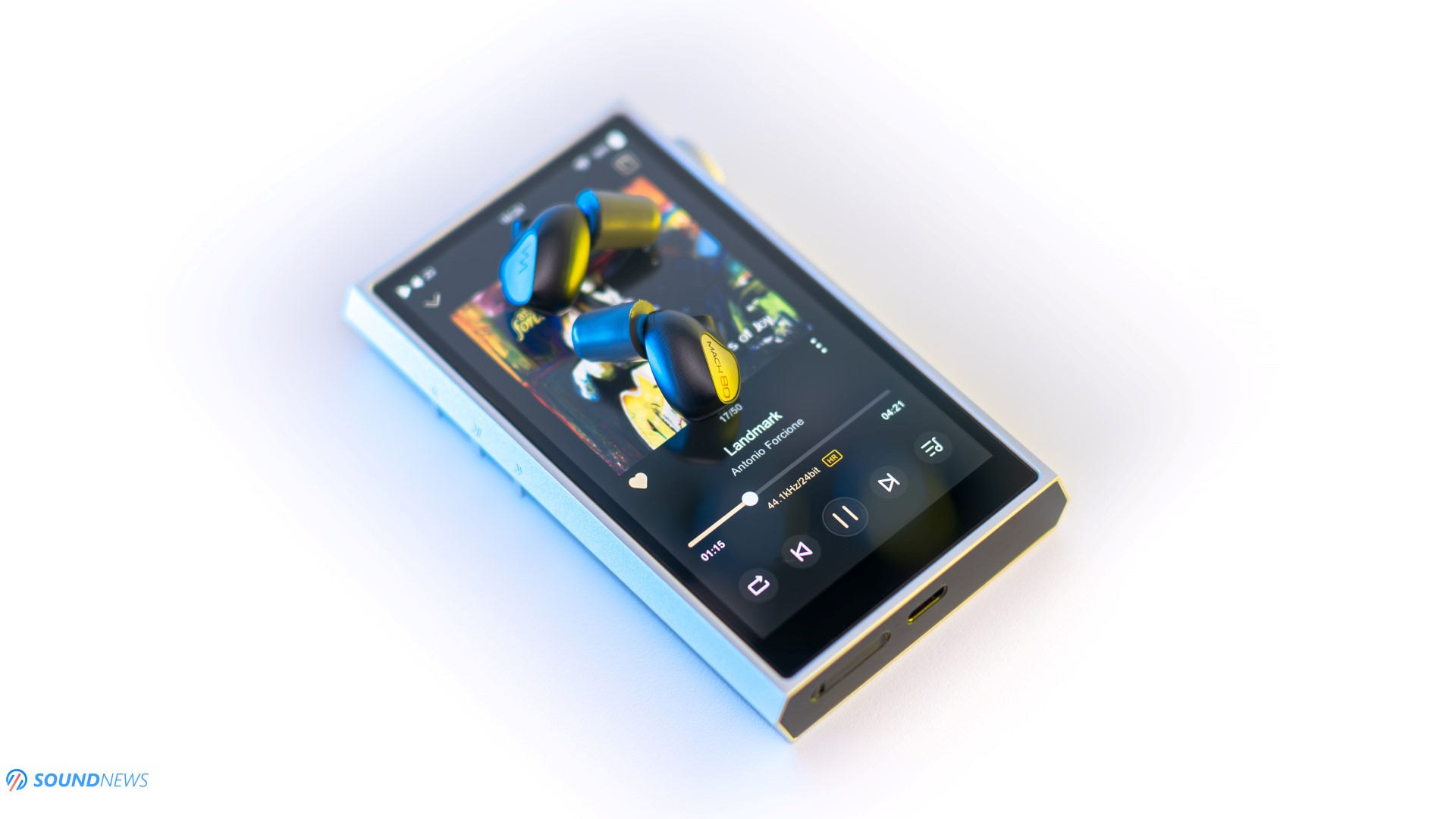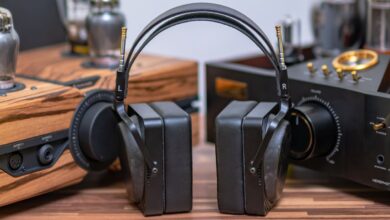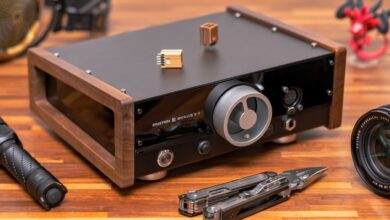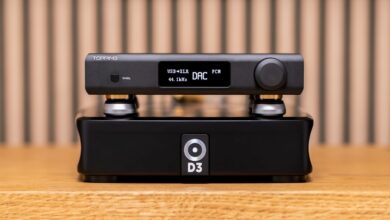Westone MACH 80 IEM Review & Comparisons – A Quiet Revolution in Sound?

Let’s face it: the world of high-end audio can be a bit…intense. You’ve got your sonic purists, audiophile elitists, and the rest of us, trying to navigate the labyrinth of technical specs and understand esoteric terminology. We’re constantly bombarded with claims of groundbreaking technology, innovative design, and life-altering listening experiences. And it can be hard to cut through the noise and discern the genuine from the hype, especially when prices soar into the stratosphere.
But then there’s Westone, a company that has carved a niche for itself through a different kind of intensity, and let’s not forget their long history in creating IEMs for musicians, audio engineers, and the usual folk who enjoy music at every corner of their lives.
Westone’s story began in the 1950s, when founder, Dr. John B. West, a renowned audiologist, realized that conventional hearing aids were failing to meet the needs of his patients. Driven by a desire to provide better hearing solutions, Dr. West began experimenting with custom ear molds, creating a revolutionary new approach to hearing care. This focus on personalized solutions, on crafting devices that perfectly fit the individual, became the foundation of Westone’s identity. Over time, their expertise in earmold technology expanded into the realm of custom-fit earphones, designed specifically for musicians. These earphones, later known as in-ear monitors (or IEMs for short), revolutionized the way musicians monitor their performance on stage, providing a clear and accurate sound that wasn’t affected by the loud stage environment.
Westone quickly became a favorite among professionals with their IEMs adopted by artists across all genres, from rock stars to humble underground bands. Their reputation for quality and innovation solidified, as musicians started praising their sound quality, comfort, and durability.
This dedication to create custom and universal IEMs that meet specific needs, extended into the consumer audio market. Westone’s IEMs are now designed for the discerning audiophile, known for their nuanced sound, able to reproduce music with remarkable fidelity, that transports the listener into the heart of the music.
Their flagship MACH 80 IEMs priced at €1749 locally and $1599 across the pond is the embodiment of this philosophy. But still, it’s a product shrouded in mystery, a whispered promise of sonic perfection, and a price tag that suggests something truly extraordinary. And it seems that the MACH 80 isn’t just another pair of IEMs; we see it as a declaration of intent. It’s a product that speaks to a certain kind of listener, a listener who values sonic accuracy above all else.
But what lies beneath the surface of this understated elegance? What makes these IEMs truly unique? Is the hype surrounding them accounted for? Do they deliver on their promise of unparalleled sonic fidelity? Is the price tag, which sits firmly in the realm of high-end audio, justified?
These questions, fuel the desire to understand the Westone MACH 80, but the answers are far from straightforward. This won’t be just a review; but an exploration into the heart of audiophile obsession. We’ll delve deep into the intricacies of their design, we’ll analyze their sound signature, dissecting the nuances of their frequency response, their imaging capabilities, and their ability to convey the subtle details and emotional weight of music.
We’ll compare them with competitor IEMs, considering their strengths and weaknesses, and their overall value proposition. We’ll even explore their ergonomics, comfort, and versatility, analyzing how they perform in various listening environments, from quiet home listening to busy streets.
Ultimately, this review aims to provide a comprehensive understanding of the Westone MACH 80, separating fact from fiction and unveiling the truth behind the hype.
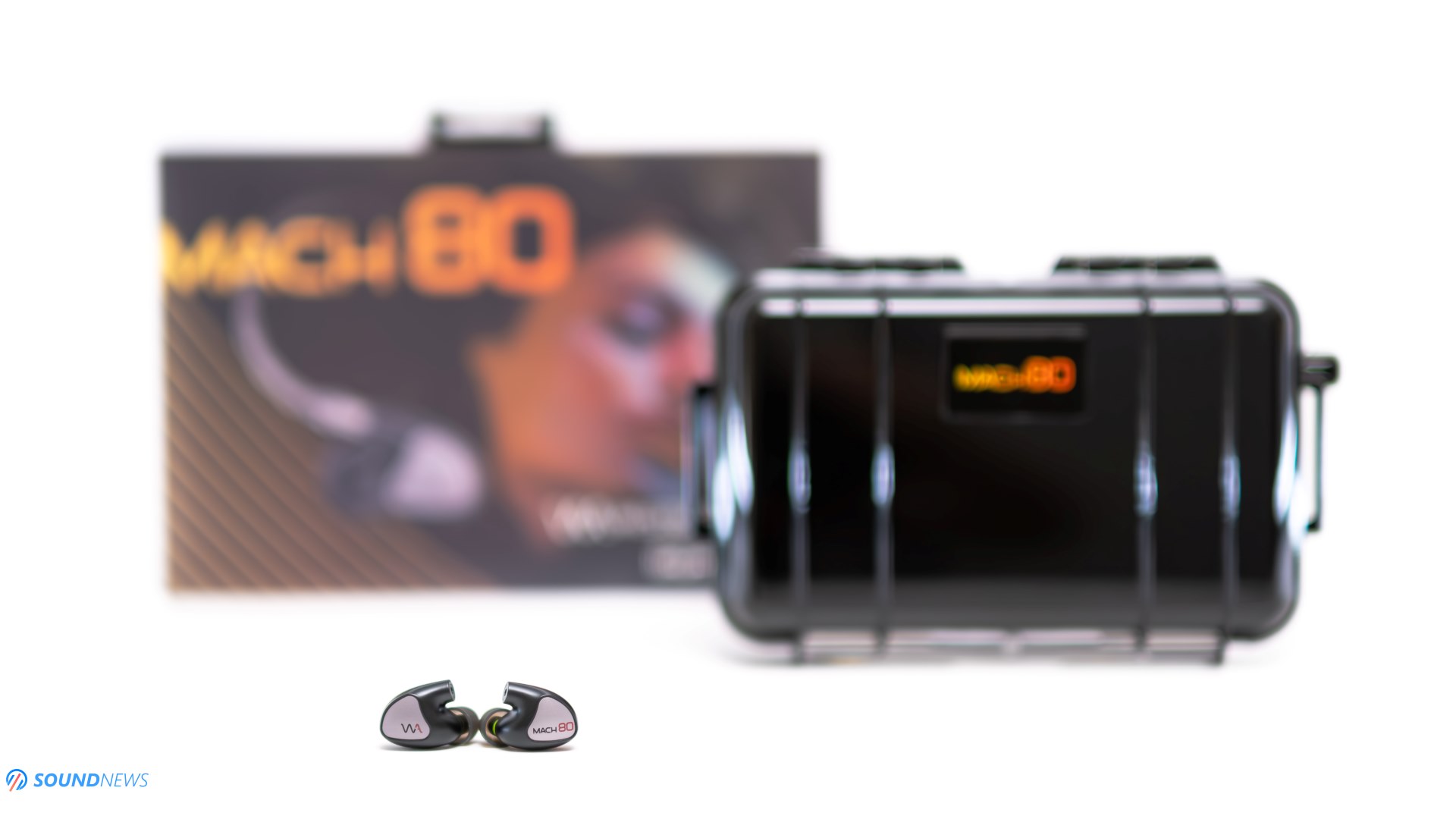
Unboxing Experience
A flagship pair of IEMs demands a premium unboxing experience and Westone delivers that in spades. A box in a box is what we are getting and regardless of your location or selected shipping, the hard Pelican case will protect the precious cargo from any hard as it’s surrounded by a healthy amount of foam.
Once you remove the outer sleeve, the magnetic case opens up like a book, revealing an oversized Pelican case. This case is definitely bigger than what I’ve experienced before, as we have a wider variety of accessories within. The insides of the hard case are adorned with dense foam that snuggly holds the IEM shells in place, the detachable Linum cable, an earwax removal tool, a carabine, and a substantial number of ear tips that should fit any ear size. We have included 5 pairs of silicone ear tips of various sizes and a similar number of foam ear tips that will offer better isolation from the outside world and therefore, a better bass extension. The foam tips aren’t your usual Comply or SpinFit tips, having an elongated design, specifically designed for their MACH lineup. While I find them comfortable long-term, there aren’t third-party solutions and if these will be showing signs of age, you’ll need to refill your ear tip stock from Westone’s website right here.
The Pelican case is shock-resistant and waterproof and if you don’t want to carry everything with you, there’s a thick soft pouch inside that seems like the perfect candidate to throw in a bag or put in a pocket.

Build Quality & Looks
My experience with Westone IEMs is quite limited, I tried their UM Pro lineup a while ago, which had transparent shells letting you see their inner workings – their balanced armatures, filters, crossovers, cables, and whatnot, making you curious even before pushing the play button.
This time around, they used a more universal design hiding all the technology behind a matte-black hard plastic shell, having an extra smooth surface that lets you insert them snuggly without applying a lot of pressure. Even if eight drivers are pushing and pulling your eardrums, I’m surprised by how small their shells are compared to their close competitors, making them (much) more comfortable in the long term. The IEM bodies are shockingly lightweight, they feel featherweight in hand and their 5-gram cable feels weightless as well, applying little to no gravitational pull when using them in long listening sessions or when going outside for a stroll.
While we don’t have an all-metallic shell, I’m surprised by the tight tolerance numbers and by their build quality, getting a well-crafted pair of IEMs at the end of the day.
Another standout for these is a much thinner nozzle head than usual. The diameter of the acoustic tube is around ~2mm, protected by a metallic mesh that blocks the excess earwax. It’s a single acoustic tube design as opposed to a triple or four-way design you can see on some of their competitors. This much thinner-than-usual nozzle limits your third-party ear-tip hunt, as the only ones that will fit them are their stock ear-tips.
Last but not least, the MACH series uses T2 connectors that resemble MMCX connectors to some degree. These can rotate getting an excelling fit without fiddling too much, the only difference is that T2 connectors are thinner and sit tighter. This connector choice will limit your third-party cable fetish, but I can assure you that the stock cables are built to last and feel solid in the hand.
They use Linum’s UltraBaX T2 cable, which can be purchased separately for $199 right here. According to them, it’s a no-compromise cable, having a perfect balance between comfort, presence, and feel. It uses silver-plated copper litz wires, quad twisted from 224 strands, having low microphonics and an impressively low impedance of just 0.6 Ω at a 127 cm (50”) cable length. According to Linum, with it “you get access to all the amazing micro details in the music which allows you to experience all the nuances, for example the overtones of the piano. Ultimately you get the most genuine and realistic, as in live performance, sound experience”.
The only part that I didn’t enjoy that much was the 3.5mm cable termination. Most of my IEMs are terminated with a balanced 4.4mm Pentaconn jack, except for the HiFiMan Svanar. However, this is still the most universal headphone jack out there and Westone doesn’t want to limit the usability of their universal-fit IEMs.
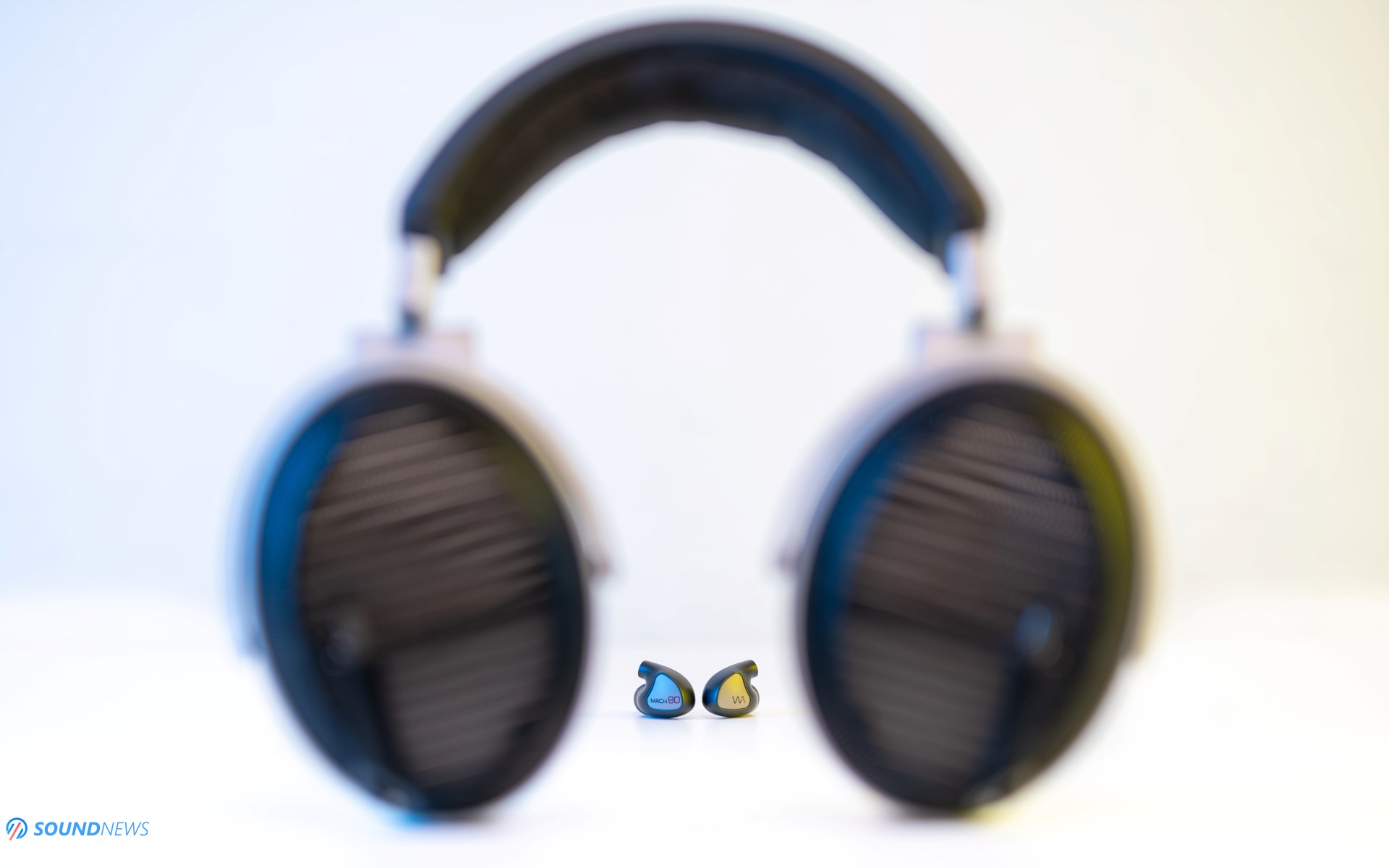
Technology Used in the MACH 80
As Westone puts it: “The MACH 80 represents the pinnacle of in-ear monitor technology, offering a flat, accurate, and balanced sound presentation. With its eight-driver system, the MACH 80 delivers a smooth, punchy, and crisp listening experience that is perfect for any musician, audiophile, or studio engineer. Recognized as a top-tier earphone, the MACH 80 provides a rich and immersive audio experience across all music genres.”
MACH 80 uses a proprietary balanced armature driver system with dual lows, dual mids, quad highs; and naturally, a 3-way passive crossover. We have a sensitivity of 104dB per 1mW of power, so these should sound decent even with low-powered devices, but for the best sound performance, nothing does it better than a dedicated DAP, desktop DAC/Amp combo that will unearth additional nuances and have a better grip over their drivers. Their 66 Ohm impedance is higher than usual, but that’s music to my ears as the noise floor of the amplifier that drives them won’t be as important as it is on ultra-low impedance IEMs. And sure enough, HiFiMan’s PRELUDE was noisy with a pair of HiBy ZETA (9 Ohms and 112 dB per 1mW sensitivity), but that was no longer the case with the MACH 80.
After trying them with a bunch of headphone amplifiers and portable DAPs, these seem easy to drive at first, but they will flourish and prosper when clean and abundant power is fed to them.
This is all you need to know about them, so let’s hit some eardrums and check them out!
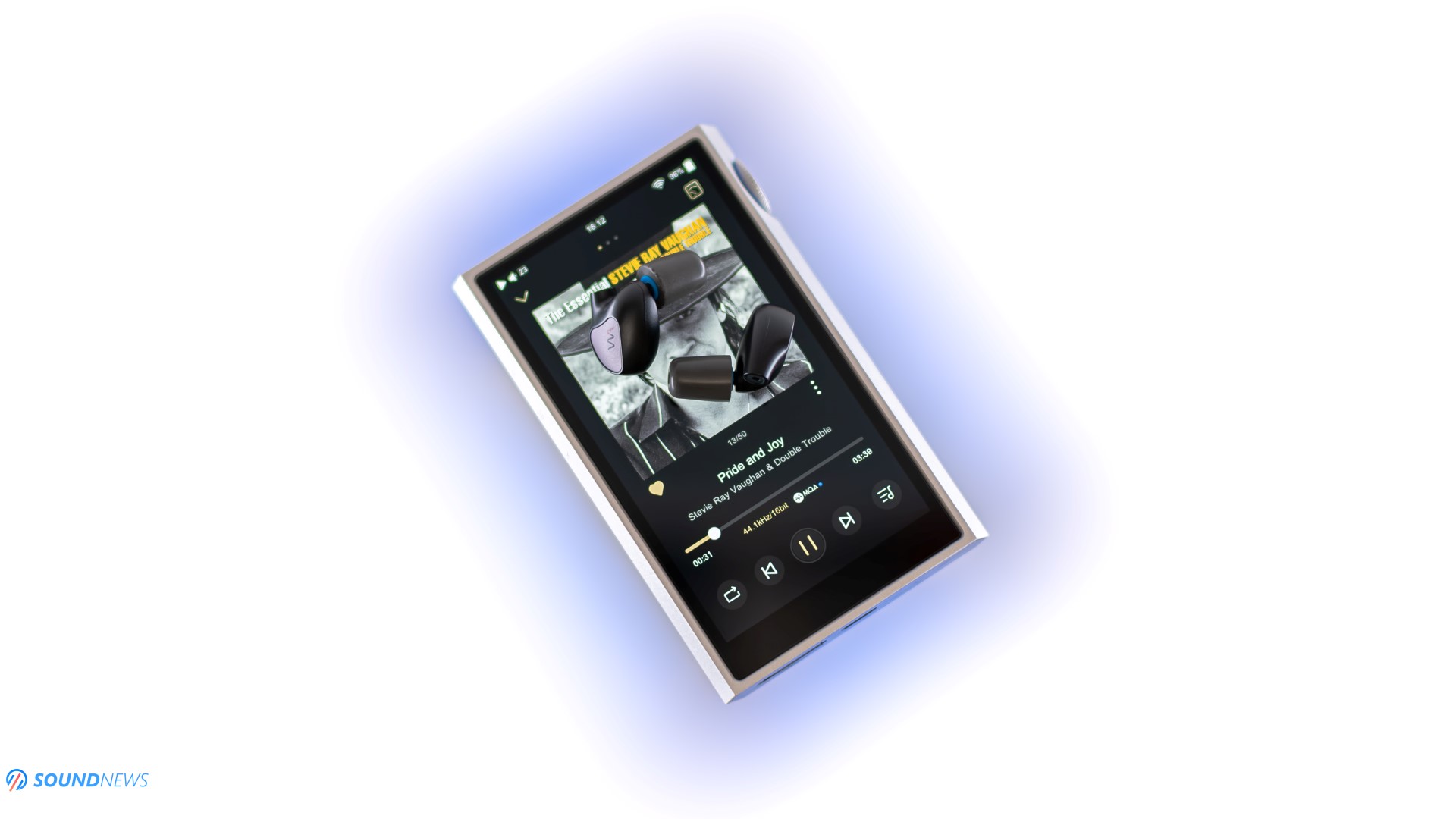
Sound Performance
I. Preliminary Sound Impressions
Let’s have a deal. I’ll leave my subjective impressions first, focusing on the user experience, and then I will describe their sound in an overkill fashion. I will measure them later on and then compare them with close competitors. Doing measurements in advance can influence initial impressions and maybe even the final conclusion, so let’s do it differently this time around.
My first-hand experience didn’t WOW me, and let me explain why. Living with TOTL IEMs like the HiBy ZETA carved entirely from titanium, experiencing the all-aluminum Sennheiser IE900, and having quite a few all-metallic IEMs from the likes of FiiO, Shanling, and Moondrop, you expect that a flagship IEM designed in the USA would have a similar construction. There aren’t metallic parts on the MACH 80; they felt flimsy and quite fragile at first, and the same could be said about their cable, which was thinner and considerably lighter than usual.
Having said that, after having them for over three months, a much different picture starts to emerge. I’ve realized that with a much smaller body and weight, these are no longer making me uncomfortable during long listening sessions. Honestly, these are by far one of the most comfortable IEMs I’ve experienced thus far. And the cable? At just ~5 grams, it doesn’t pull on the IEMs when going outside for a stroll. There is almost no gravitational force applied to the IEMs and their cable, and the nozzle is also considerably thinner compared to the usual IEMs I have around. Therefore, their custom ear tips won’t apply a lot of pressure around your ear canals, leading to nicer comfort.
Sometimes we forget how important comfort truly is. In a 15-minute comparison session, we usually neglect such things and choose the one that (subjectively) sounds better. However, once comparisons end, comfort remains a factor that can significantly improve or diminish the listening experience.
The MACH 80 and its incredibly sturdy yet lightweight cable are indeed not that impressive at first sight. But as the saying goes, don’t judge a book by its cover. Over time, I began to appreciate their understated look, lightweight design, cable, and exceptional comfort.
The same applies to its sound. An IEM can often impress immediately with a colored sound that boosts a particular range, and it’s usually the bass or the treble. However, as time passes, you start realizing that the music isn’t supposed to sound like that, even if it’s extremely fun, engaging, airy, and extended at the very top. Reference-tuned IEMs usually don’t impress you right away, only after experiencing several albums covering a wider variety of music genres.
And that’s exactly my first-hand experience with the MACH 80. Having them for more than three months, trying a few desktop setups and several portable digital audio players (DAPs for short), I started to understand their tuning and appreciate their skills.
If you’re an avid reader, then you already know that crazy dynamics, immaculate technical performance, and an engaging sound signature are something that I greatly enjoy. To my surprise, the MACH 80 nailed a perfect blend of technicalities that would impress a seasoned headphile, with a pure, unspoiled sound that doesn’t color the final outcome.
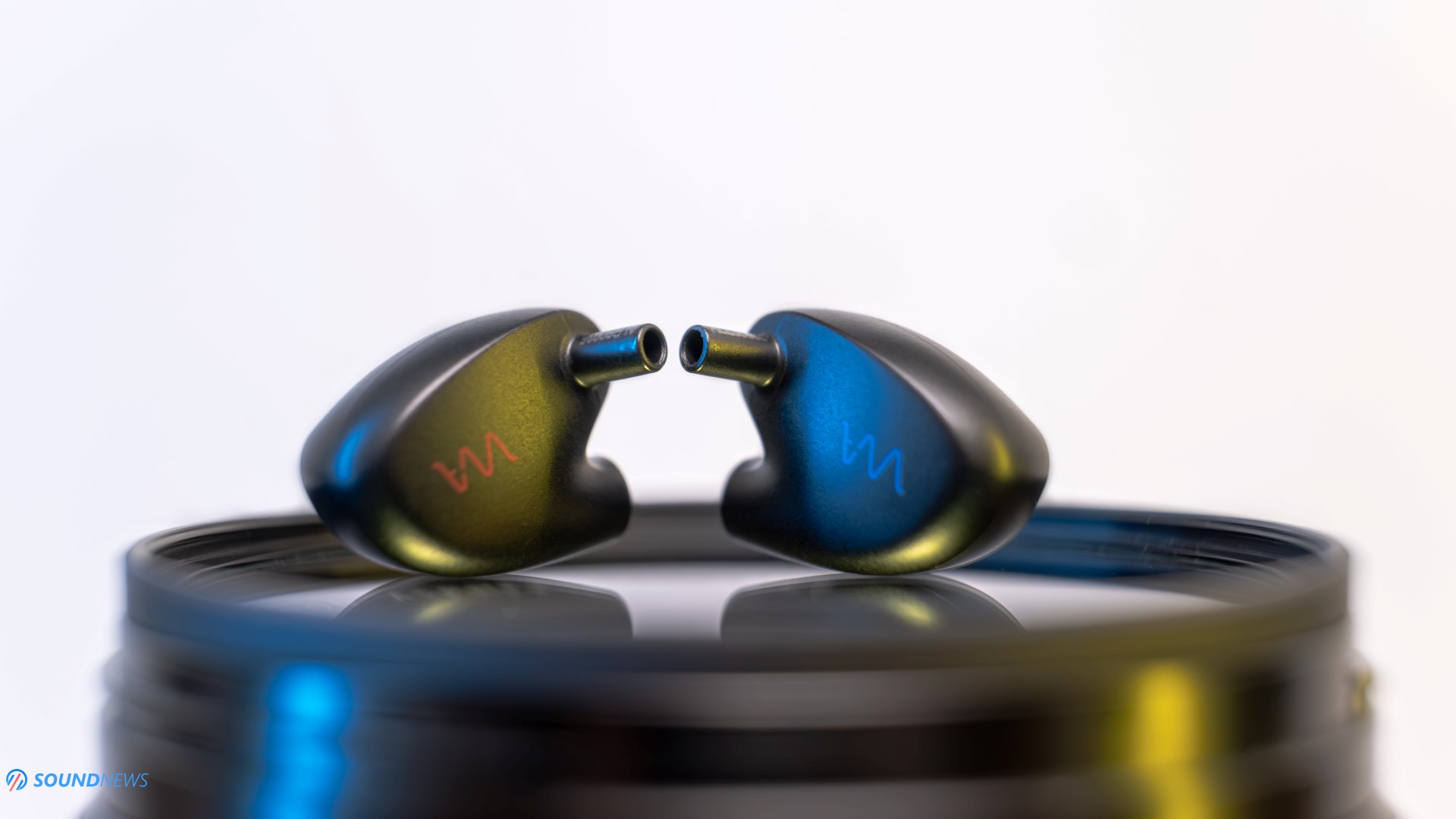
II. Resolution & Sound Transparency
I have experienced a good deal of IEMs by now. I’ve owned several custom-tailored IEMs as well, but at the end of the day, universal IEMs have a much bigger appeal to me nowadays. I’m no longer a lone ranger but a husband, a father, and…a storyteller. I no longer listen to music alone; I like to share it as much as possible and plant seeds for future generations.
When my 9-year-old son asked me to build him a desktop headphone setup, I kid you not, I was the happiest man alive. Nowadays, I’m always asking for a second opinion about the things that come for a review. I’m always questioning my judgment. Did I say it all? Was I biased? Did my subjective opinions cloud your initial impressions?
I no longer listen to music alone, but usually as a family, and you know what? I have so much fun doing it! Some IEMs could fit inside the ear canals of my beloved, but the MACH 80? Having the thinnest nozzle and some of the smallest ear tips on the market, even music-loving kids could try these with a DAP in hand. And that’s exactly what we did.
Listening to the MACH 80 was quite a revelatory experience for my tribe, but surely, I was considerably more impressed, given my long-life experience. As a rule of thumb, balanced armature drivers are regarded as unearthing a higher amount of resolution since they need less amplitude to be moved. I’m currently using a pair of loudspeakers (Raidho TD 2.2) that have the lightest tweeters in existence, the legendary ribbon tweeters hand-built in Denmark that have only 11-micron thickness, meaning these are 50 times lighter compared to conventional dome tweeters. The result? The purest sound I ever experienced, with the nicest treble extension without becoming bright and bothersome.
There’s always a balancing act in terms of technicalities and musicality, and I consider that Westone achieved their goal. I find the MACH 80 exemplary in terms of detail retrieval, or how much information they can uplift. From my IEM collection, the MACH 80 is currently the resolution king and, as an added bonus, nothing feels out of place in terms of frequency response.
There are obvious gaps and rises happening in the upper midrange and treble regions, but all IEMs are doing that. More importantly, the MACH 80 manages to balance the frequency response without becoming boomy in the bass, muddy in the midrange, or ear-slashing in the treble.
Their resolving abilities will win over not only seasoned headphiles and IEM collectors but also musicians and mastering engineers since they can hear so much more of their music and, of course, of their flaws.
What’s interesting is that no matter what material plays on them, I didn’t find them clinical, harsh, or plain boring. When the timing gets right (more about this in the next chapter), the sounds start aligning perfectly; the pace, rhythm, and timing play a crucial role in making the IEMs sound cohesive, pure, and unaltered, and that’s what I’m getting from the MACH 80 every time I press the play button.

III. Dynamics & Transient Response
Another thing that impressed me right from the start was their ability to keep up with some of the most demanding tunes. Be they lightning-fast electronic tunes, or super crowded rock tunes, busy funk, and blues in close quarters, the MACH 80 was always pressing down the gas pedal.
These can go fast, lightning fast with the right gear and tunes, and as a direct result, you should expect shorter decays than usual. These feel snappy and exact when it comes to timing; therefore, the sounds are always in tune, sounding pure and unhindered. The MACH 80 has two armatures that deal with the bass region, and while the bass feels as energetic as it is on the MACH 70 blessed with a single bass driver (quite unusual, right?), the MACH 80 gains a lot of territory when it comes to bass control, speed, impact, and decay. MACH 80 offers an overwhelming sensation of tightness, and that comes mainly from its clean bass performance that never lingers for a microsecond longer.
The MACH 70 could be a bit more fun, especially with modern tunes, but the MACH 80 is much closer to real performance, sounding tighter and stricter in all things that have to do with the acceleration, sustain, and decay of the music. It sounds right from the get-go, and this feeling will persist throughout the listening sessions.
Overall, these are incredibly fast-sounding IEMs, and their transient response is immaculate. The only thing I sometimes wish for would be a stronger slam in the bass, but luckily, that can be easily achieved with a fun-sounding little gizmo like the Shanling M5 Ultra, Onix XM5, HiBy R6 PRO II, or R8 Mark II. I’m currently using the M5 Ultra, as it’s a bit more engaging sounding than the rest, infusing a bit more bloom into the bass region, to which the MACH 80 responds immediately.
Tears of Joy by Antonio Forcione (Qobuz / Tidal) is an album that slowly started growing on me, feelings that I share with the MACH 80. Antonio strums his guitar like a veritable Italian; there is so much life in every stroke of his hand, the melody line is smoother and higher pitched than usual, and the lone words that are barely spoken in the background are defined and outlined. The bass guitar carries lots of weight and emotion, and you can literally feel the drumsticks massaging your eardrums. It’s a soothing and engaging track at the same time. It’s crowded close to the end, but it was never creating an ugly mess with the Westones. The sound came together beautifully, and I grooved along with a happy grin on my face. The high-resolution nature of this album was picked up immediately, and even if the M5 Ultra is not regarded as the cleanest sounding DAP out there, the MACH 80 solved the puzzle and corrected the minor gripes of the Shanling.
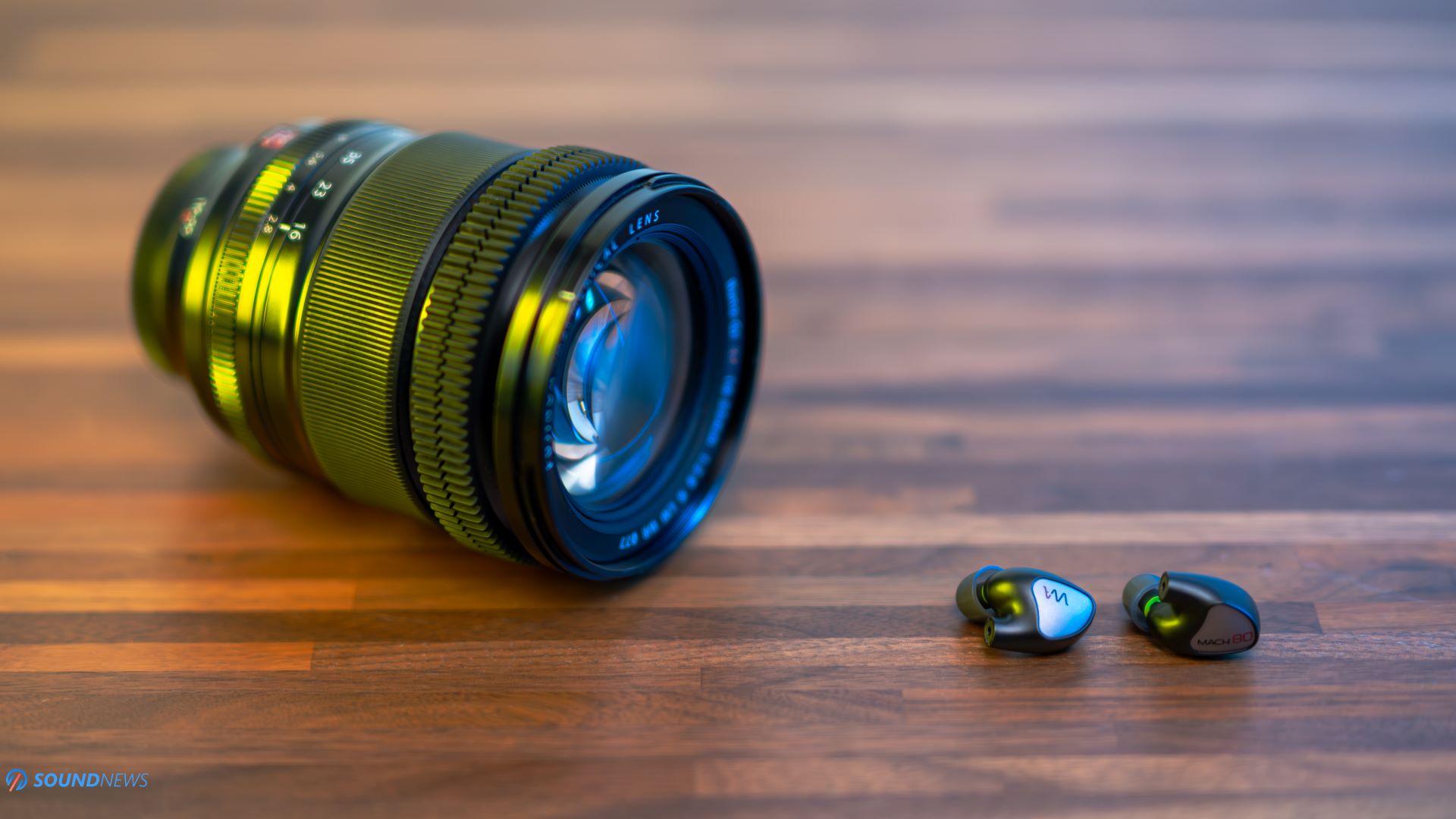
IV. Soundstage & Imaging
I know what you are thinking about. It’s kind of crazy writing about soundstage for a minuscule IEM that goes into your ear canal, having tiny drivers that are kicking your eardrums. And you would be right… to some extent. Indeed, most IEMs can’t compete with open-back desktop headphones, let alone with floor-standing speakers when it comes to scale and the overall picture that unfolds.
Obviously, I’m not bombarded with hundreds of sounds bouncing off the walls, but the sounds are still coming from all directions. The only difference is that I no longer hear the music with my body, but only with my ears. The best part? The grand spectacle isn’t shoved inside my head like affordable IEMs usually do.
Sure, the music is not hovering at arm’s reach, but hey, the crossovers do their job with flying colors, capable of separating the sounds while leaving some space in between each one of them. The right word won’t be soundstage per se, but stereo separation, which does incredible things to live performances.
In this regard, the IE900 and the ZETA were quite impressive, and you could easily mistake them for medium-sized open-back headphones (like Grado, Focal, OLLO, or Sennheiser) sounding similarly, trying to manipulate the listener into believing that big drivers are playing the music. I don’t want to hype these to cloud nine, as there are still a few drawbacks that I will mention in a minute, but the MACH 80 scores higher points in terms of stereo separation and depth compared to the aforementioned models. A single driver IEM done right, like the IE900, can still sound a bit more cohesive and time-aligned since there aren’t crossovers in sight, but when it comes to scale and separation of the music, how much air there is in between the notes, the MACH 80 are playing in a higher league. It’s a marginal improvement—I mean, I’m still listening to IEMs, but they are no longer tiring me out as much since the extreme stereo effect is no longer at play.
Since none of my music was making me claustrophobic, I believe Westone was able to divide and conquer all musical genres with this approach, adding extra layers of sound that could delve deeper into the mix, focusing on tiny details without pushing yourself or the volume levels to dangerous territory. So yeah, this chapter still makes a lot of sense, and let’s not forget that MACH 80 wasn’t crafted only for audiophiles with deep pockets, but also for mixing & mastering engineers, musicians, and whatnot. All of them need to hear all of the subtleties, the good AND the bad stuff, depth information, stereo separation, and I’m sorry to tell you the truth, but such skills usually inflict higher wallet damage.
After an almost 10-year pause, Seigmen released a new album – Resonans (Qobuz / Tidal) that resonated with me from the first track. Progressive and ideally—underground rock is something I’m always exploring for multiple reasons. Such bands usually play for their souls; rarely do they want to stand out. Seigmen is not an underground band, but most of my prog-rock heads probably haven’t heard of this Norwegian band. I specifically chose this band and this album to show off the stereo separation skills of the MACH 80. Starting with the first track, the sounds are overwhelming with their SPL, the energy is going through the roof, yet the music is kept under control, and the sound doesn’t become harsh or bothersome. This is far from a perfect album that will showcase the movement of the notes across the room in an airy manner; on the contrary, this album is almost trying to destroy tiny IEMs, mashing and piling the notes, ideally three guitars, vocals, and drums, ALL at the same time. Surprisingly, the sound isn’t becoming an ugly mess, and that is something I still enjoy and follow with interest. A job well done, indeed.
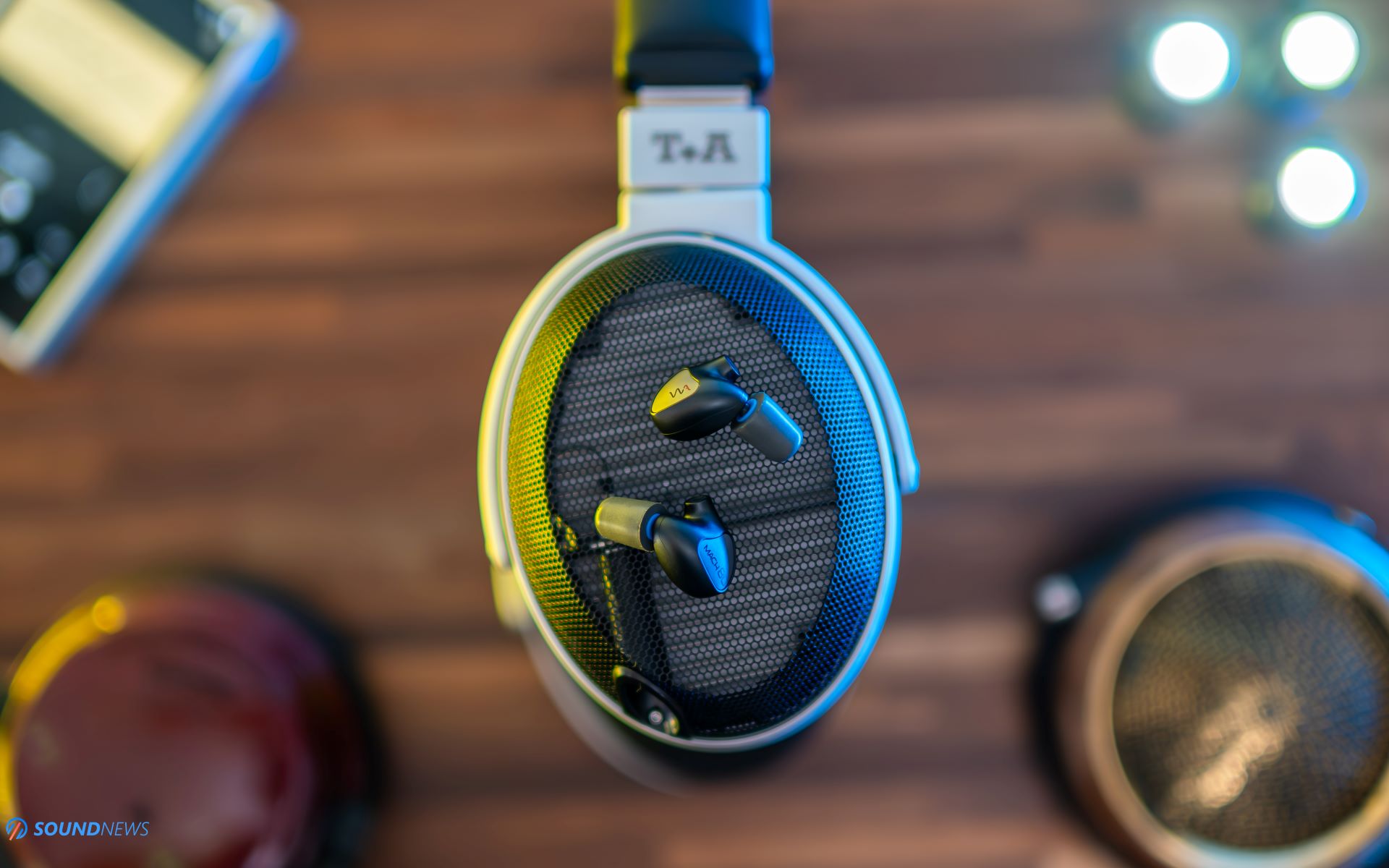
V. Universal or Reference IEMs?
When I travel around the world, I tend to use universally tuned IEMs that can still deliver decent resolution on reference tracks, but more importantly, I need to go with the flow and detach myself. I need to feel great while doing so, be it at the top of a mountain or in the deepest Carpathian forests. I tend to use affordable IEMs that I won’t regret if a bear mistakes them for a snack.
I’ve been using the Meze ALBA lately, which are what I would describe as genre-master IEMs. They go well with everything, but only if you close the door shut to audiophile-proof terms. Sure, they don’t resolve that much info and are not exactly lightning fast, but they do justice to the music, and even if I can still bring much better IEMs on such trips, the ALBA are still my daily drivers on short or long travels.
The MACH 80 is more of a reference-grade IEM that prides itself on everything I just mentioned in previous chapters. Yes, it’s incredibly technical if you care for such things, but it’s also universally sounding, having a pure and unaltered sound. MACH 80 won’t present you with a milk-and-honey presentation as the ALBA does, but at the same time, I’m not experiencing the listening fatigue or the treble excess that usually plagues affordable Chi-Fi IEMs. Westone didn’t remove the engagement factor, the way some treble-intensive IEMs can for some of us. The sound is sharper than usual, and the leading edges are also quite strong, but since the music is time-aligned and everything syncs in place, the sound is not getting aggressive or fake. This part is difficult to maintain and control, but I guess decades of experience under the same banner have the last word.
Yes, the MACH 80 are reference-tuned IEMs that can be universal with the right source and material. System matching? It depends on personal preference, but I wouldn’t use them with ultra-linear gear nor with amplifiers that heavily use negative feedback to bury the noise. I would choose warmer and sweeter sounding sources, and that’s how I arrived at the Shanling, Onix, and HiBy trio.
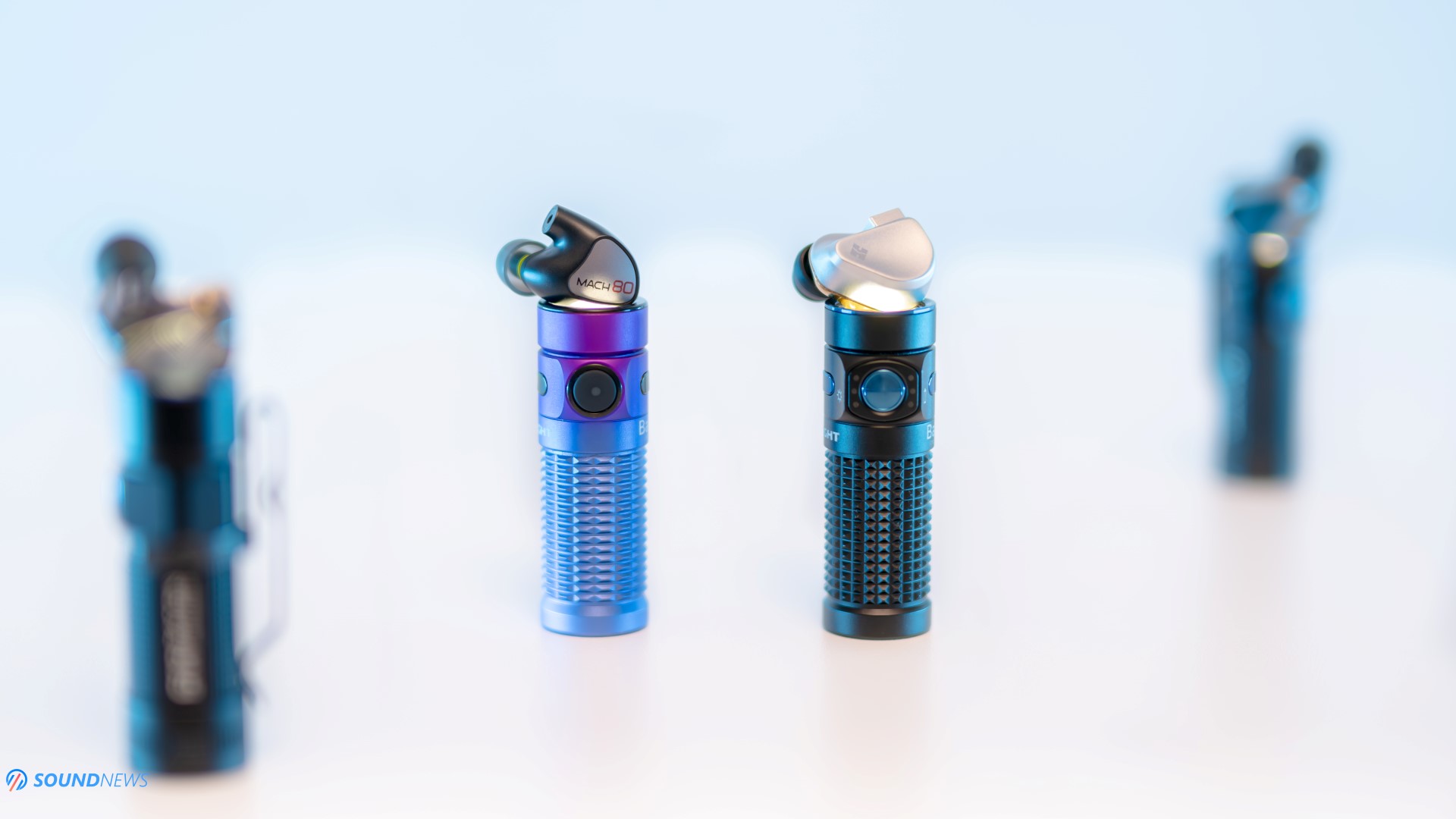
Frequency Response
VI. Bass
The MACH 80 is an 8-driver balanced armature IEM. It’s quite sensitive and doesn’t need tons of power to be driven, but that doesn’t automatically mean they will work with every headphone jack out there. A very high volume is one thing, and having a perfectly controlled sound is something else. Small dongles should do a decent job in maintaining their sound tight and clean, but after trying a few sources and amplifiers, it’s clear to me that they like a good deal of current going through their armatures for a nicer control of the sound, especially in the bass. The bass is the frequency region that changes the most depending on the source and amplifier used. I came to the conclusion that it’s there in the right doses, and this is what I would describe as a linear bass performance. It’s not subdued and it’s not all over the place. I can still hear 20 Hz notes on the right music, and all of that energy is kept under strict control. The bass seems layered and clean, without becoming boomy or elevated from linearity. You can add some fun with a mild EQ (they respond quite well to EQ) or simply use a punchier-sounding source and amplifier. A potent DAP would be more than enough, as I’m still writing these words with a Shanling M5 Ultra DAP feeding the MACH 80 with all sorts of tunes. Sometimes I wish these would slam a little harder, and if that’s your thing, then the MACH 70 will better suit your needs.
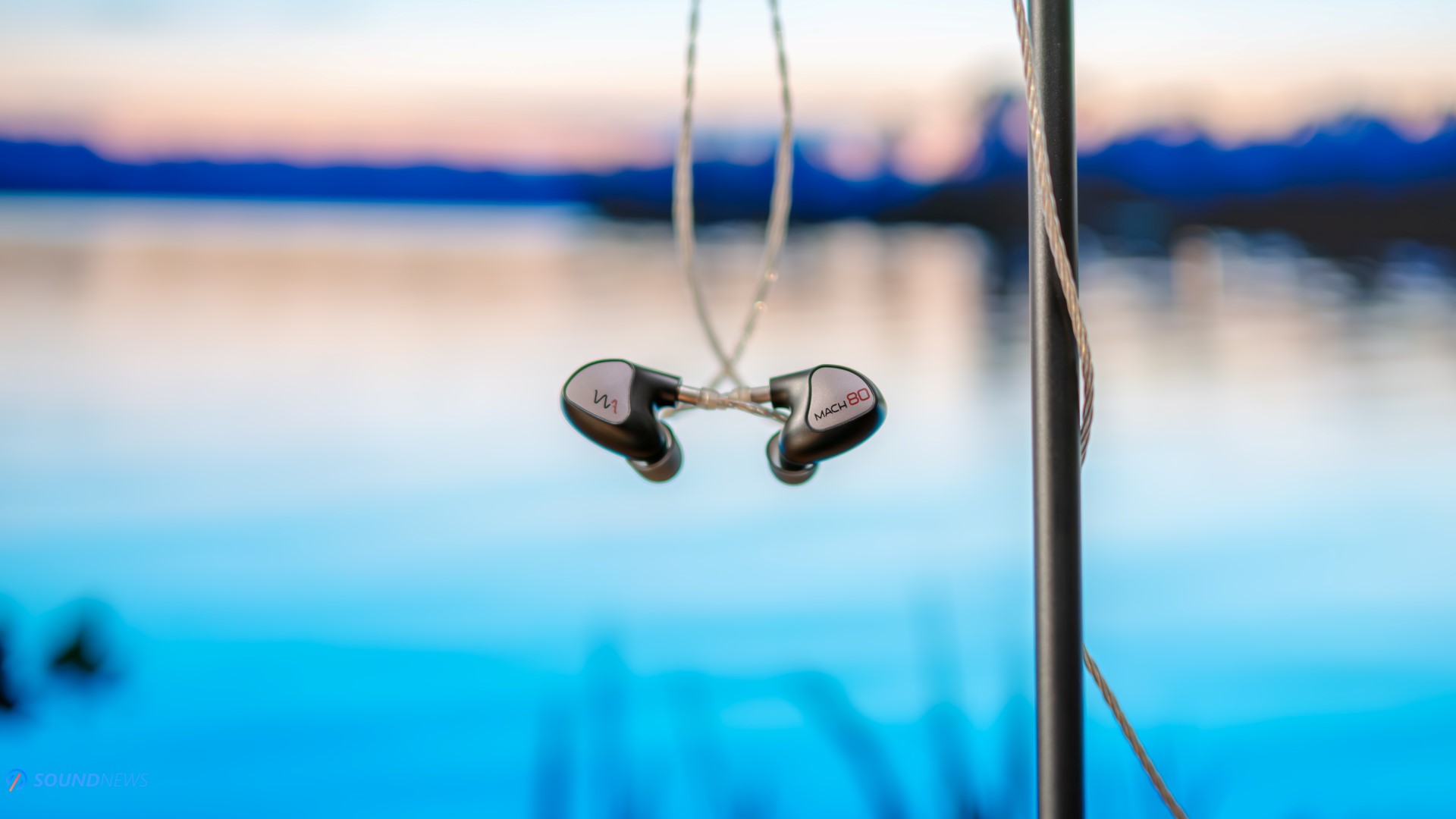
VII. Midrange
A reference tuning might scare off potential buyers, but I still wanted to crank that midrange a notch higher, and that’s one of the reasons I’m using the Shanling M5 Ultra, which overflows it with warmth and sweetness. The MACH 80 was quite frankly, blooming on it, shapeshifting their tonality a tiny bit. After enabling the high gain, the sound got bolder and weightier. Their timbre went from great to outstanding, and that’s why I like to fiddle with several DAPs. One might work great with a particular IEM, while another might bloom with a completely different IEM. FiiO’s M15S rocked hard with the Sennheiser IE900, HiBy’s R8 II was the bee’s knees with their ZETA, and now the MACH 80 pairs great with the M5 Ultra. With my reference desktop setup, which consists of an end-game Roon Server, an R2R DAC, and a class-A fully-discrete amplifier, the MACH 80 sounded even better, pumping wackier dynamics, while further freeing the sound, for a more relaxed presentation. The M5 Ultra and my desktop head-fi battle station excel in the midrange department. I built my rig specifically for a life-like presentation, and unsurprisingly, the Westones picked up these traits immediately. Having a reference tuning, they respond well to EQ and other sound enhancements, and you can alter their voicing depending on your preference.
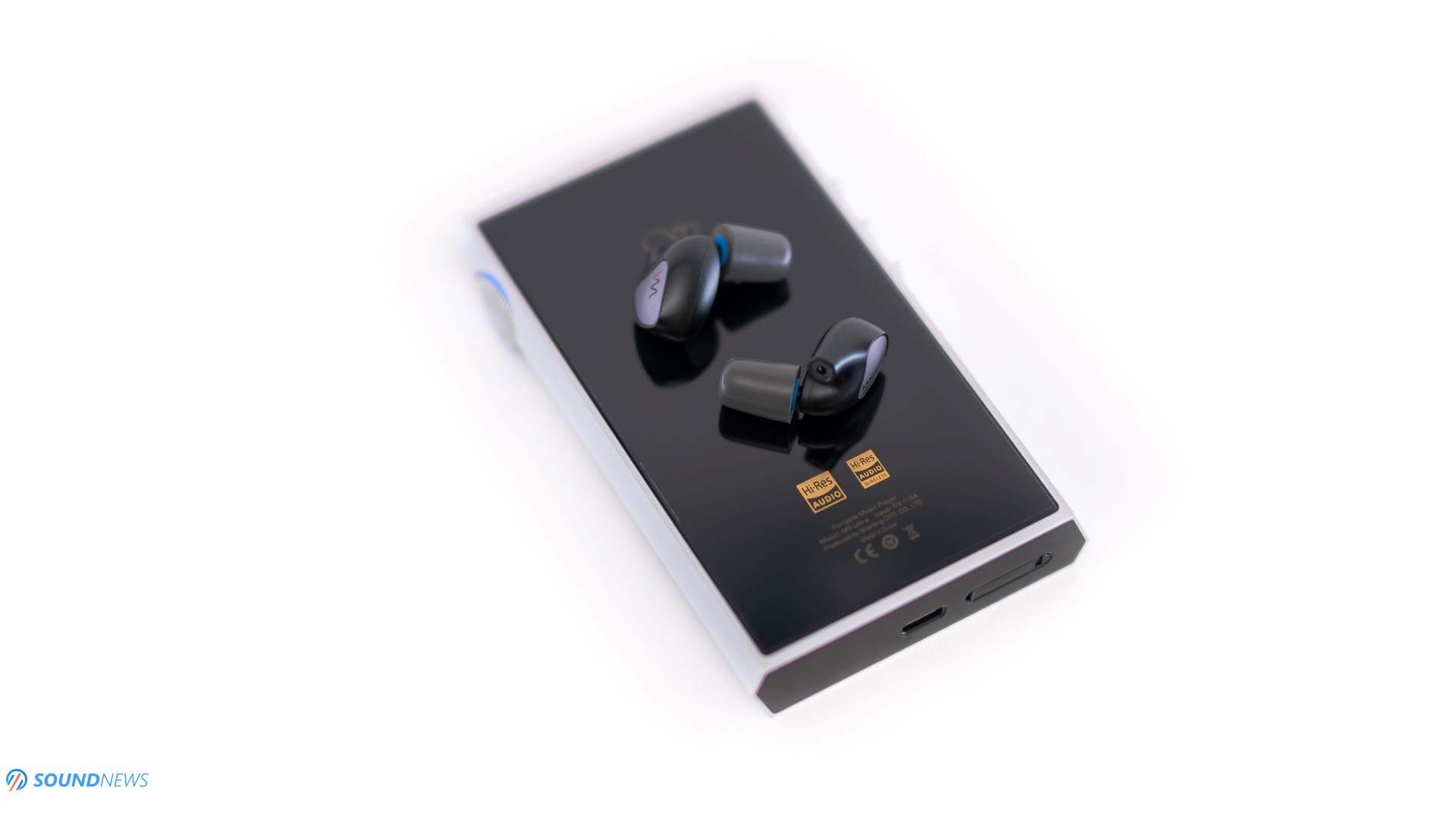
VIII. Treble
Some of the latest IEM releases from the likes of FiiO and HiBy have an outstanding treble performance, thanks to dedicated EST drivers that render the upper-frequency region. The problem with such hybrid IEMs is that the crossover circuit becomes the priority since we are dealing with dynamic, balanced armature, and EST drivers, all of which have different sensitivities and impedances. As a matter of fact, the FX15 of FiiO sounded so disjointed in the treble, like it wasn’t part of the music but a separate entity, that I was forced to send them back. Westone uses 4 balanced armatures to render the upper register, and I must say, the final result is a clean, tight, and extended treble delivery that doesn’t roll off treble information.
Although balanced armatures and EST drivers can sometimes have a slight metallic tint, after a minimal run-in time, the MACH 80 doesn’t exhibit such demotivators, staying true and linear and ultimately getting an accurate treble response and a balanced sound reproduction. With the wrong DAP or dongle, these can exhibit a minor treble emphasis in the most sensitive part of our hearing (between ~5 and 7 kHz), and that’s why I prefer to use sweeter-sounding sources and amplifiers, which can add some fun to the mix.

IX. Detailed Measurements
After offering my subjective impressions, let’s check how things look from an objective standpoint. I used a Rockna Wavedream Signature DAC and HiFiMan PRELUDE headphone amplifier to do the heavy lifting. The measurement rig was a MiniDSP E.A.R.S. system calibrated with IDF (IEM Diffuse Field) compensation files. Please note that E.A.R.S. does not follow any IEC standards, meaning that my readings can’t be used as reference measurements or anything like that. I’m doing them for fun, getting a general idea about their sound signature and performance. I measured them a couple of times, as both channels needed to be matched. No side pressure was applied to them; they stayed still in their natural position.
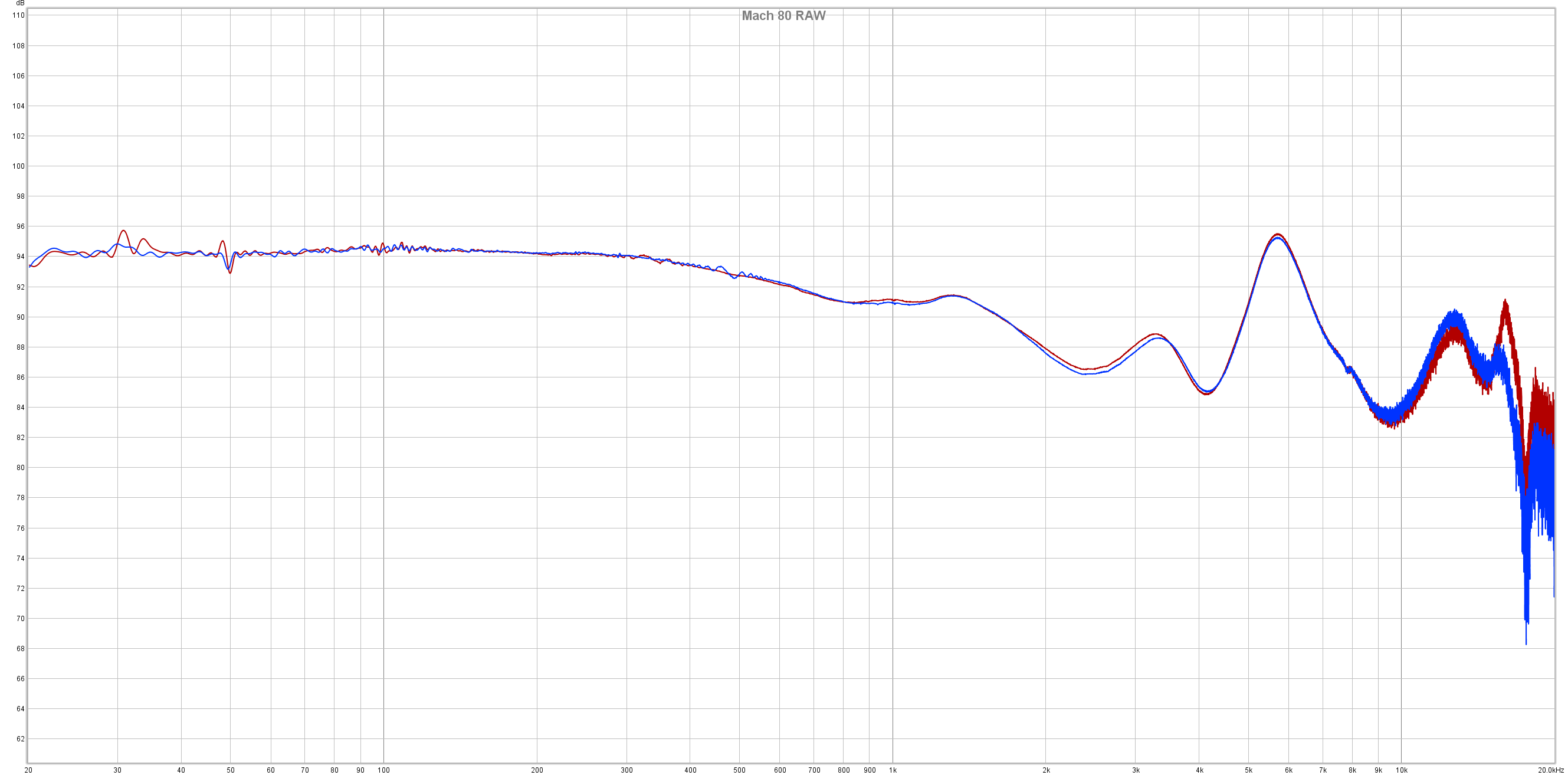
Take a look at a heavily zoomed graph in which I used the smallest silicone tips. The first thing that struck me was their excellent channel balance. I don’t believe I’ve received a cherry-picked pair, and I’m happy to know that several IEM manufacturers are (still) measuring and matching their drivers. I’m not sure about the rest of their lineup, but the MACH 80 excels here!
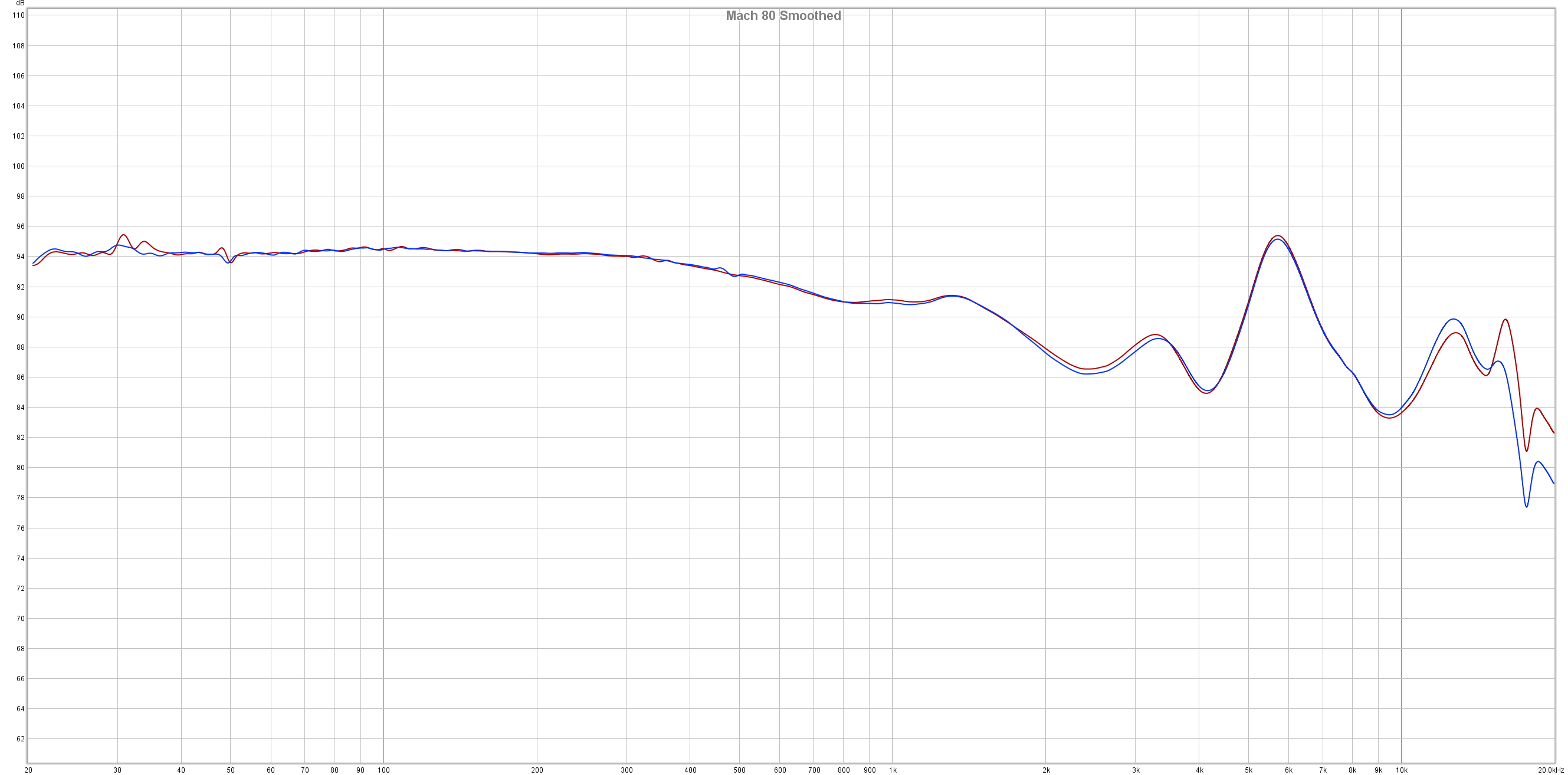
After a gentle 1/24 smoothing was applied, you can see their outstanding linearity from 20 Hz up to about ~700 Hz, where things slowly roll off. Do note that I used a 300 Hz sine wave at an SPL of 94 dB, so anything higher or lower than 94 dB is a rise or a dip. The sub-bass looks perfect, and so does the mid-bass region, never deviating up or down from linearity, not even by a dB. The midrange is pretty good, but the signal starts to gently roll off at 1 kHz, and at close to 2 kHz, the signal loses 8 dB, hence having less energy in the upper midrange. My test jig is (luckily) not following the Harman curve, and the treble might look like it’s riding a roller coaster, but I assure you that’s normal behavior. The most sensitive part of our hearing (between 5 and 7 kHz) is elevated only by a single dB, never sounding bright or edgy, not even on aggressive rock tunes. There are minor slopes at various frequency ranges in the treble, but not a single rise from linearity, meaning that no matter what you do, these will never sound off or fake in the treble. Regardless of the source and source material, MACH 80 was never harsh, and if you look closely, there is a treble roll-off happening past the top octave that makes them enjoyable to listen to in long listening sessions.
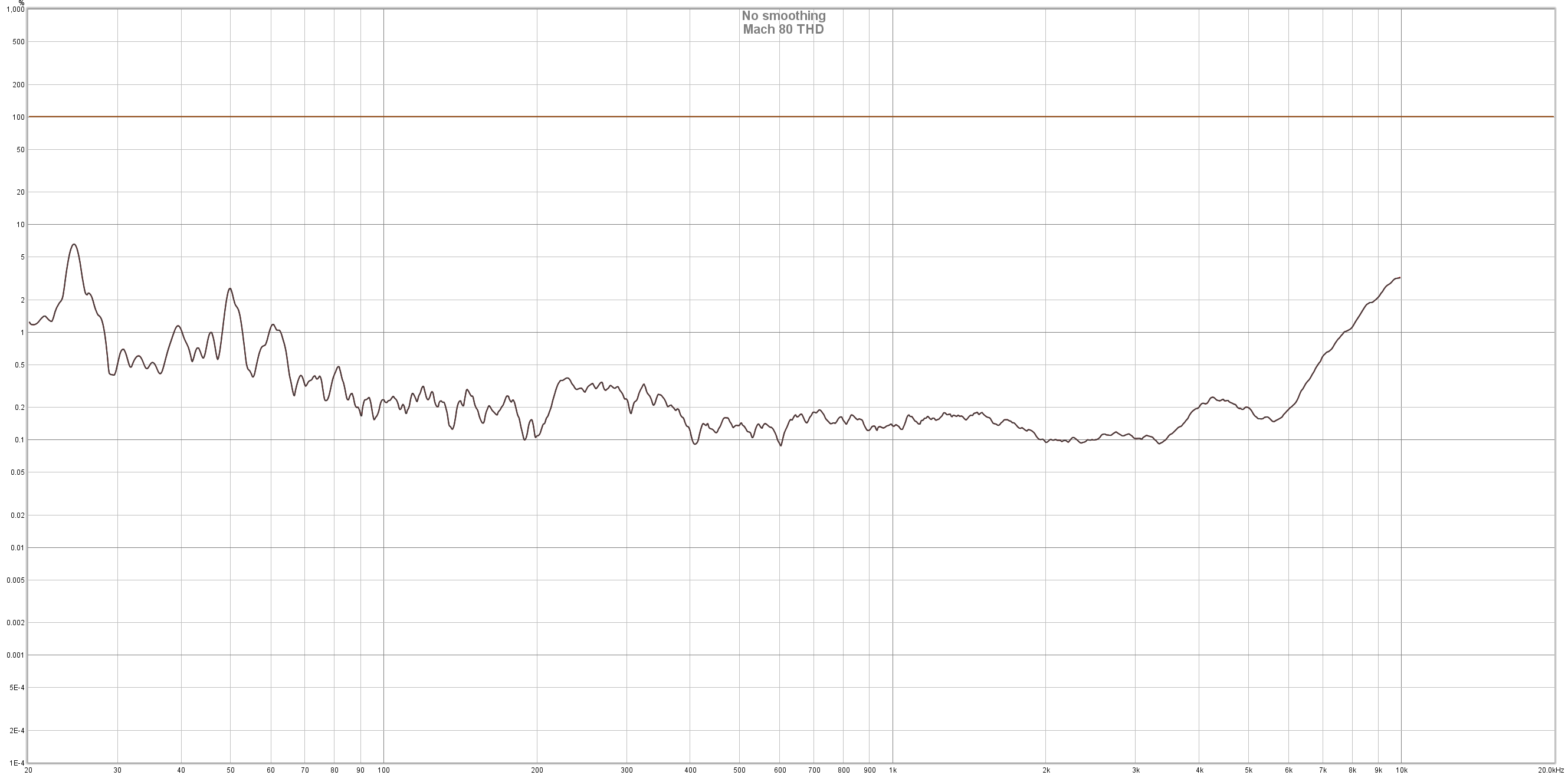
Their distortion (THD) reading is good but not great. Do note that I’ve sent a 94 dB test signal and not an 84 dB one as recommended by MiniDSP, so naturally, the distortion reading is higher than usual, especially in the bass. It sometimes reaches 6% but usually stays in the neighborhood of 0.3%, which is great.
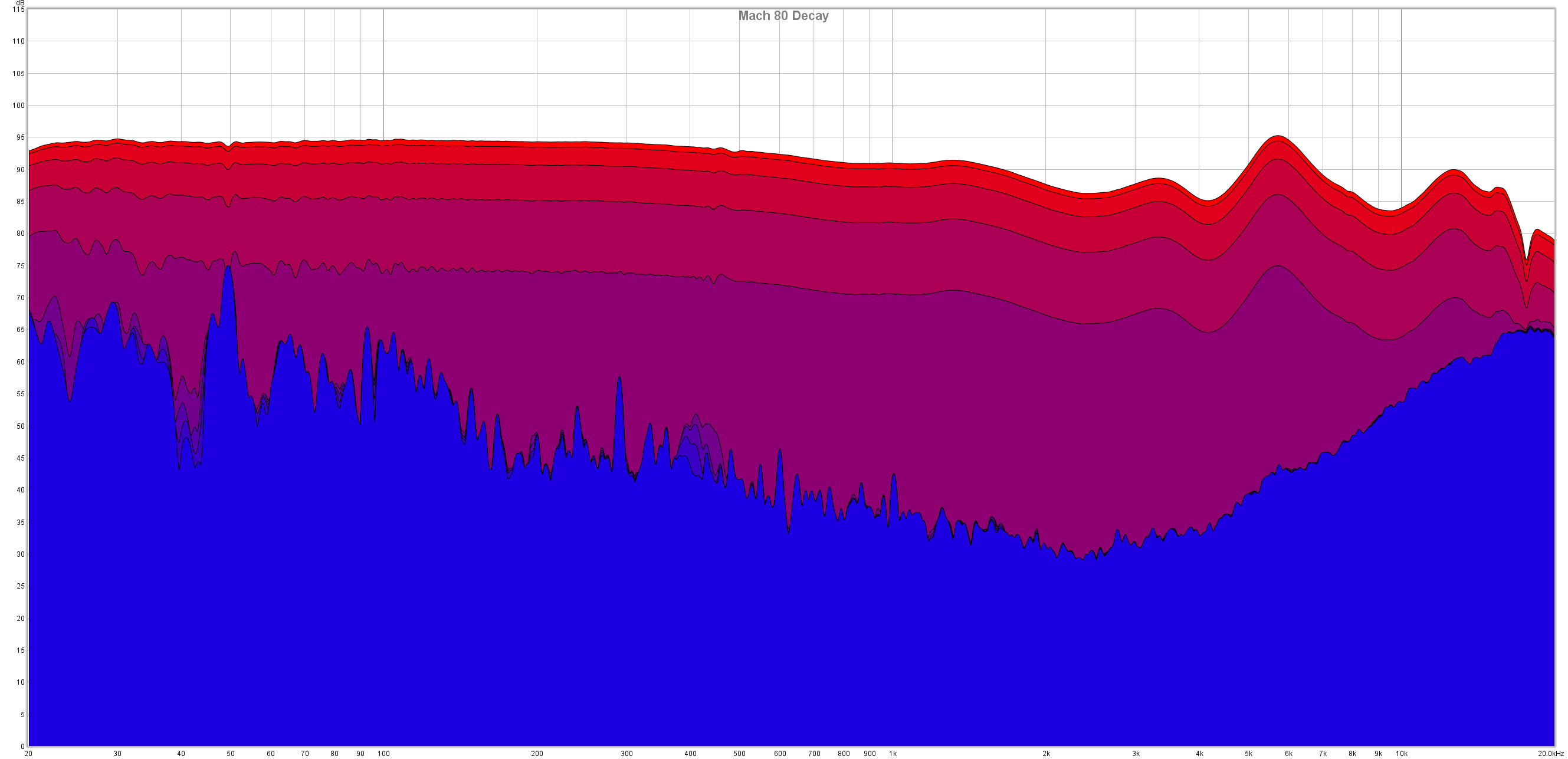
The spectral decay looks interesting, to say the least. I presume that Westone used acoustic filters to tame down the treble region, which slowed down the treble, getting a longer decay in there, in line with the bass region. The final result is a coherent and time-aligned sound, which is extremely important in a high-end multi-driver IEM design.
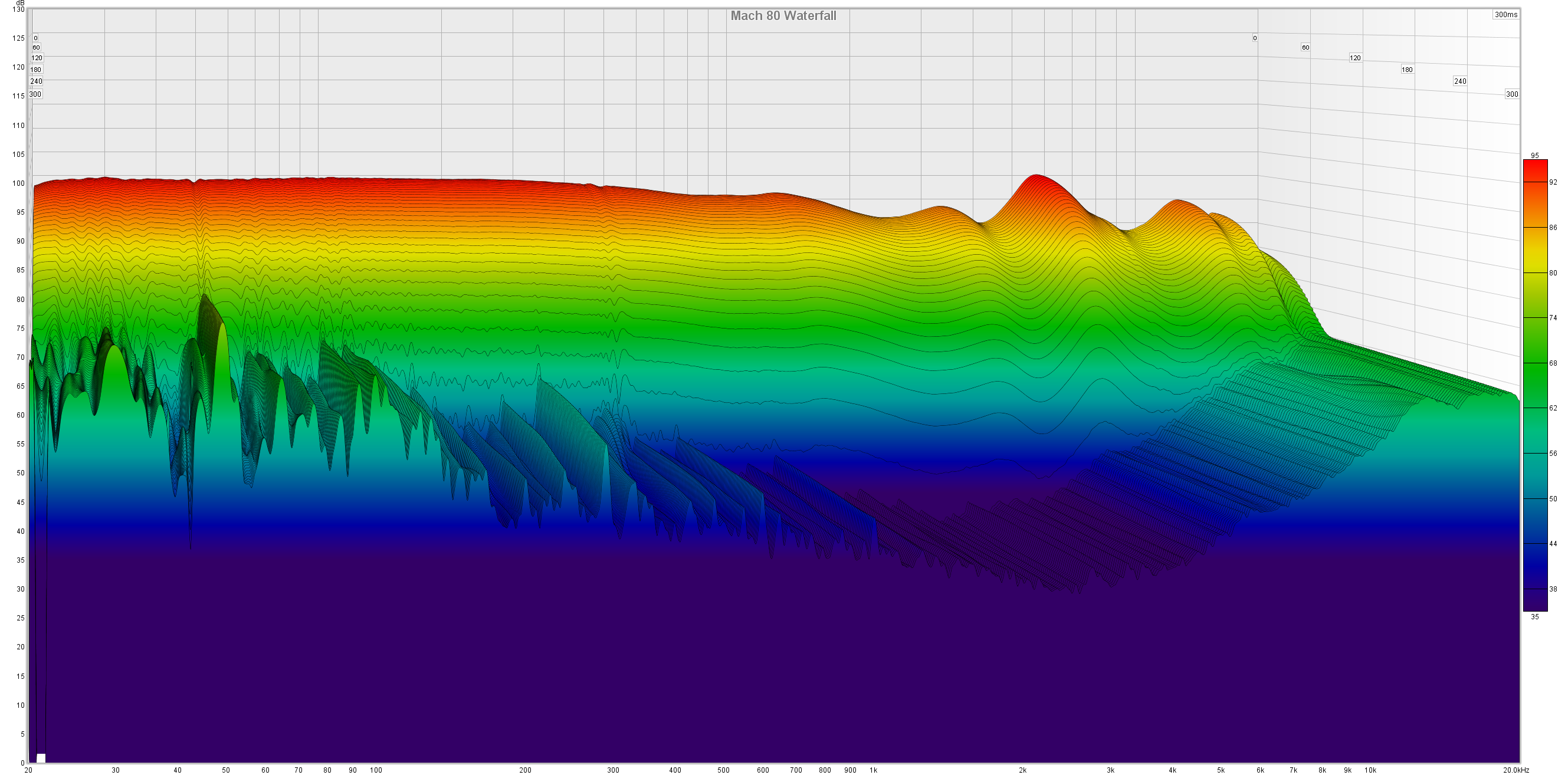
Waterfall combines the FR plot and spectral decay into a single graph, and you can see their FR from a different perspective, including their slow-ish decay up top.
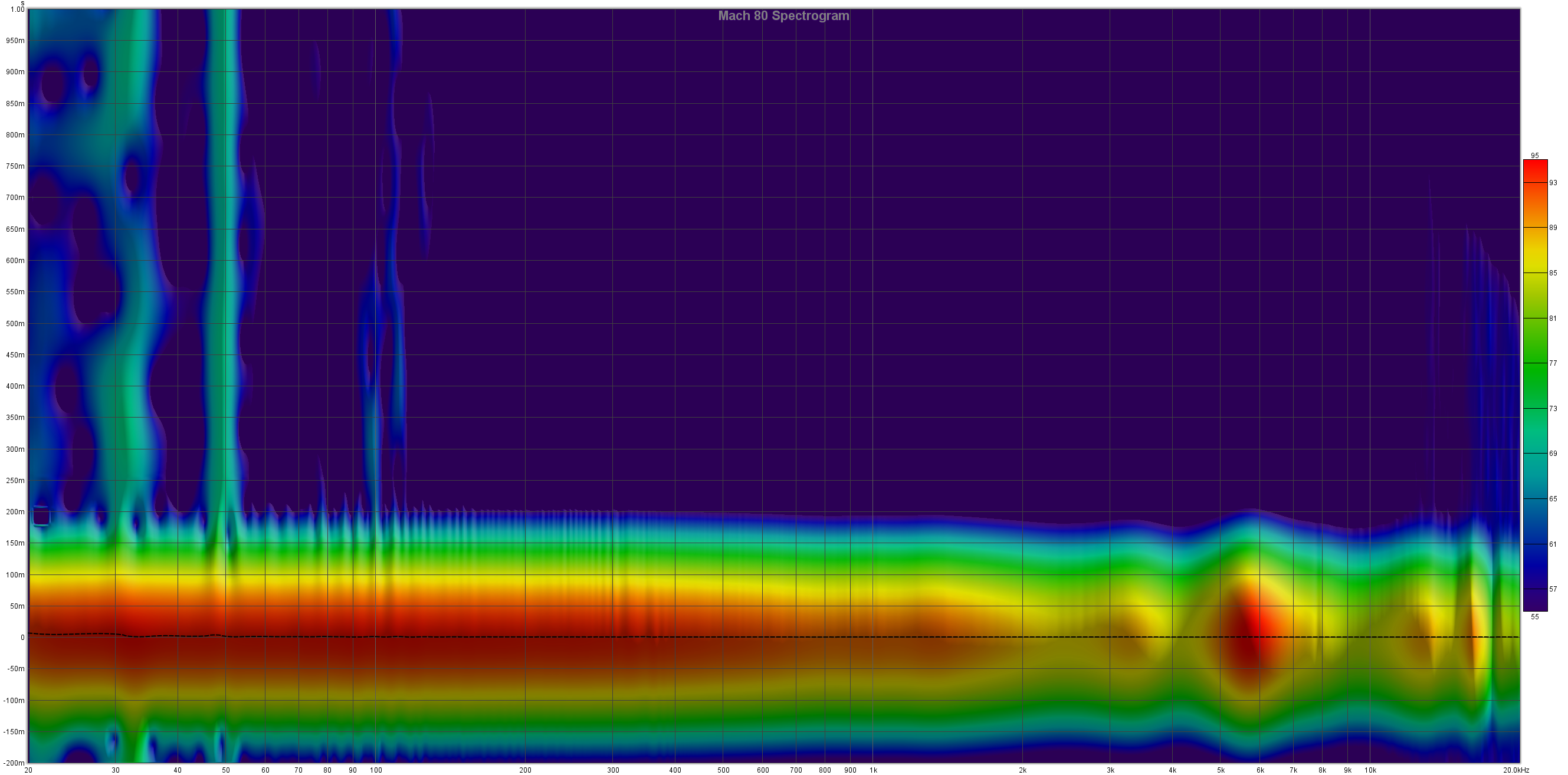
The spectrogram shows a longer ringing happening at 30 Hz, 50 Hz, and then in the top octave, which suggests the use of a crossover. The regions affected might be crossover points, which add sound fluctuations, or maybe those are just slight distortions generated by the lightweight body.
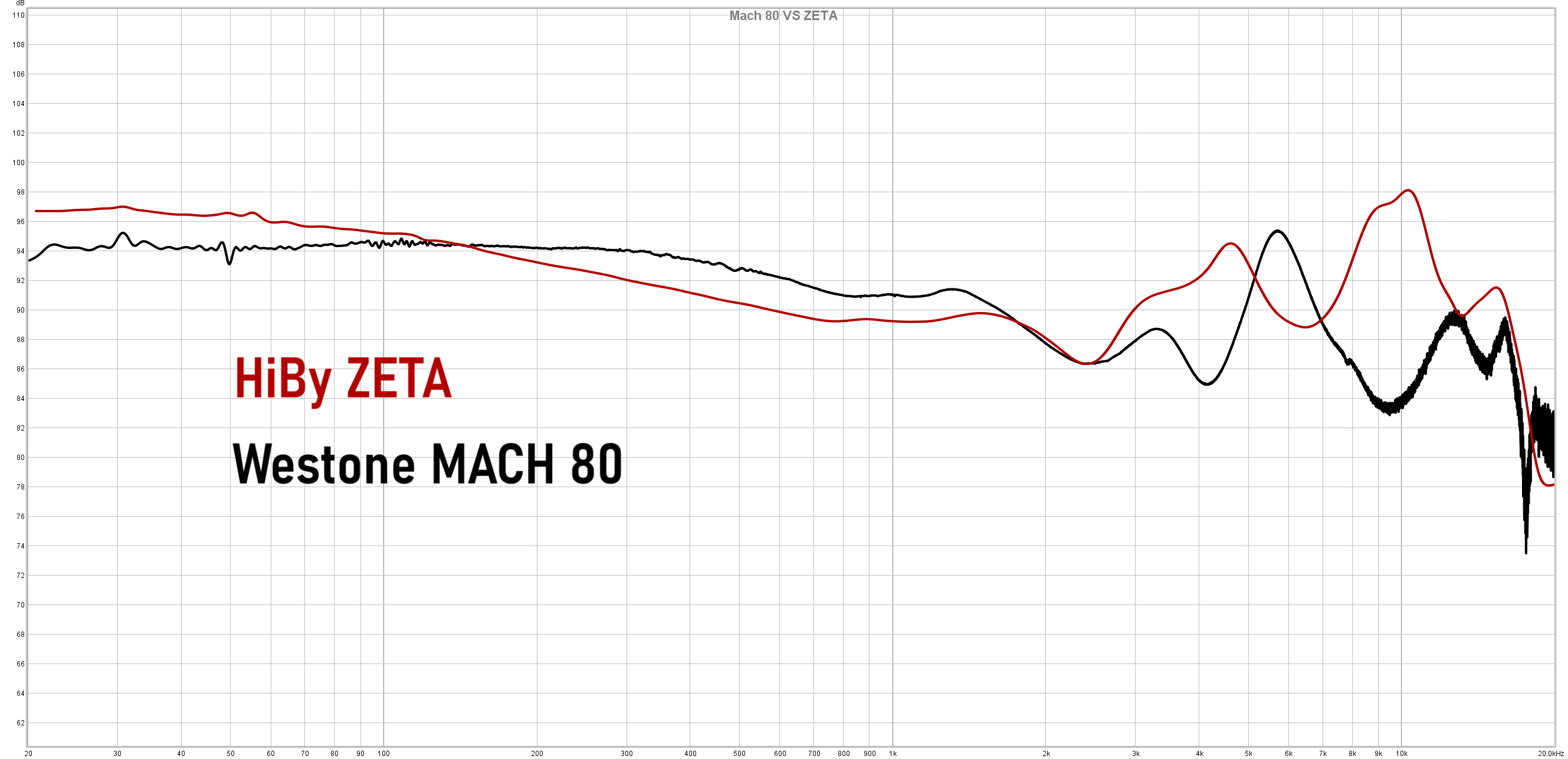
Last but not least, here is a short FR comparison between the MACH 80 and the HiBy ZETA. MACH 80 is considerably truer to the original signal, while the ZETAs have a more V-shaped tonality, emphasizing the bass and treble energy while reducing some energy from the upper midrange.
So far, I’ve got a close-to-perfect frequency response, albeit with minor issues when using higher volumes.
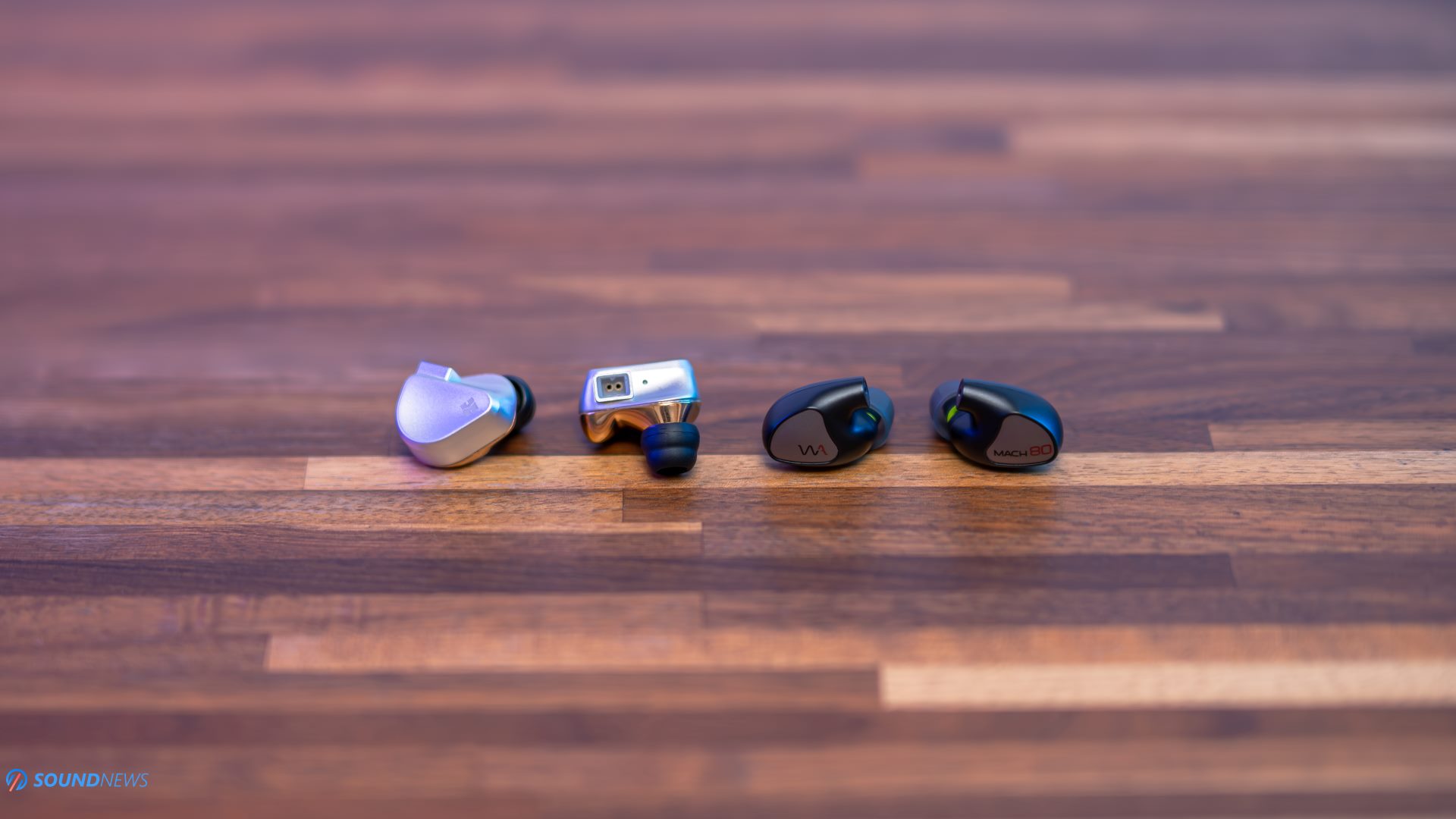
X. Two Interesting Comparisons
A. Westone MACH 80 ($1.599) VS HiFiMan Svanar ($1.999)
Disregarding their build quality and cable differences, plus the shallow 2-pin connector of the Svanar which will shut down your third-party cable hunt for good, let’s focus on their sound instead.
I used their stock 3.5mm cables, and right off the bat, there was quite a difference volume-wise, as I needed additional steps on the Svanar to arrive at a 90 dB SPL. The volume difference was influenced by their sensitivity (100 dB on Svanar vs. 104 dB on MACH 80).
While lots of folks still enjoy the up-front sound of the Svanar, the MACH 80 is without a doubt a more spacious-sounding IEM that adds more space in between each note. The sound can get congested on the Svanar, especially on crowded tracks, while the Westones beautifully arrange everything in front of the listener without overlapping the sounds. You will feel the difference immediately on well-mastered live records, and orchestral works but also with crowded tracks as well. This has nothing to do with depth or soundstage; only with stereo separation, which is simply better on the MACH 80.
The third difference that was felt almost immediately was their overall tuning and frequency response. As I have mentioned already, the MACH 80 is both technical and universal, thanks to its balanced tuning and glare-free treble response. These work great with a wide variety of music, something that I cannot state about the Svanar. The HiFiMans are more lit up; the treble is emphasized, and the “S” sounds can become a burden in long listening sessions. The Westones don’t call for your attention that much and will leave you be while jogging, but the Svanars are constantly drawing your attention with their upper treble region that isn’t only extended and elevated from linearity, but also sharper sounding than usual, getting clinical and quite sterile. If system matching is a minor thing on the MACH 80 sounding great out of almost any headphone jack, the Svanar needs a much higher current output for better control over their drivers AND a smoother and sweeter sounding source that will tame the upper treble excess and infuse more life into them. While I can’t call the Westones musical sounding, they do appear as such in a direct comparison with the Svanar.
Last but not least, the sound is simply more cohesive, closer to a real-life performance on the MACH 80. These appear by a hair faster sounding and therefore have a nicer transient response, note sustain, and decay. Unfortunately, the Svanar isn’t as cohesive and time-aligned, getting a minor driver rattle and distortion when going higher than 90 dB. The sound remains transparent, clean, and controlled at higher volumes on the MACH 80, while on the Svanar, distortion becomes readily apparent, even slightly altering the frequency response at higher volumes. My ears started ringing with the Svanar after browsing my music collection for two hours due to a higher-pitched treble, and I also encountered a slight discomfort since they applied a higher pressure on my ear canals.
The Westones are, simply put, the lightest and most comfortable IEMs I’ve used thus far, and this part alone makes them desirable for long transatlantic flights.
After additional comparisons, it was readily apparent that the Westones could resolve a higher degree of detail. Additional nuances were racing to the surface while remaining consistent at every volume level. The Svanars weren’t as clear, defined, and detailed on the micro-scale, and what’s more interesting is that the tiniest details weren’t as defined at lower volumes as they were at higher volumes. The Svanar sounds great once you crank the volume higher and dynamics start kicking in, things that weren’t happening with the MACH 80. Regardless of the volume level, the Westones were ultra-detailed and engaging.
Overall, we have different tunings, technicalities, and skill sets, and which one will be more to your liking is a question that only you can answer. I need to be impartial, and while I do have a healthy dose of subjectivity, what intrigued me is that a more wallet-friendly IEM can still challenge and even outperform pricier IEMs.
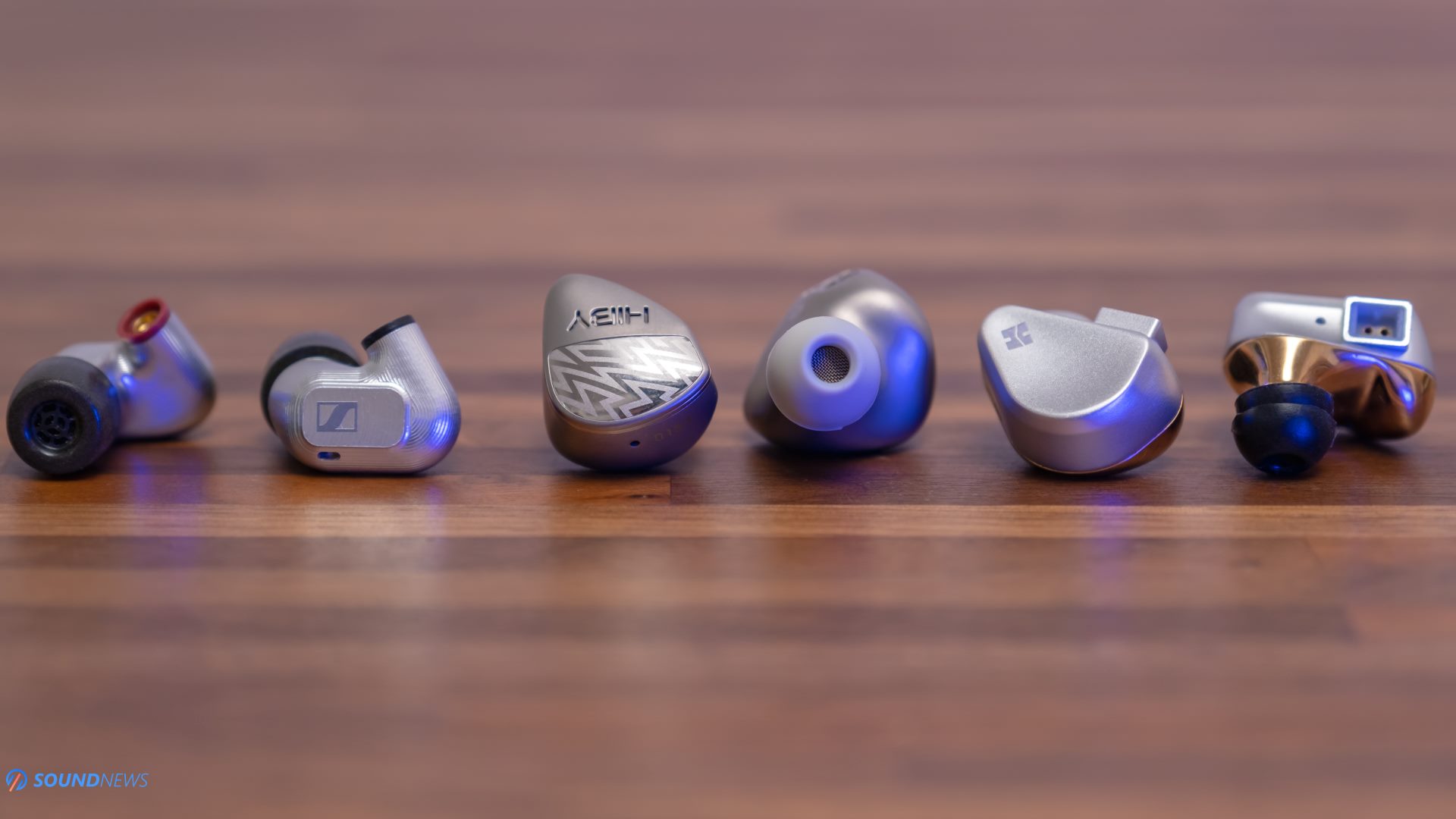
B. Westone MACH 80 ($1.599) VS HiBy ZETA ($1.399)
This time around, we have a more affordable IEM that goes with a fun and impactful tuning. ZETA’s build quality is top-notch, and the same can be said about their detachable cable and packaging. The MACH 80 offers better protection with the hard acrylic case, plus we have a bigger collection of ear tips, suitable not only for seasoned audiophiles but also for the young generation.
As much as I like the ZETA, their much bigger shell and weight make them less desirable in long listening sessions. Going outside for a walk, these might drop out from your ears due to a higher body and cable weight. While their cable is the thickest I’ve encountered from the IEM kingdom, it is also the heaviest cable, which has a higher gravitational pull on the IEMs themselves, lowering the long-term comfort as you’ll need to reinsert them once in a while. On the other side of the coin, you won’t feel the Westones inserted deeply, and therefore, the comfort game is easily won by team USA.
The Westones present themselves with a highly refined and brightness-free sound. The sound wasn’t buttery smooth per se, but the overall experience felt more relaxed, never trying to flex a facial muscle when treble-intensive tracks started pounding my eardrums. MACH 80 has an even frequency response going with a reference tuning, while never sounding clinical or harsh. The Westones sound engaging on the right music, but the ZETA is more so, especially when listening to high-dynamic range tracks. The Westones have a linear bass quantity and top-notch quality attached, but the ZETAs are bringing additional doses of energy to the bass, to the point of becoming boomy and (slightly) all over the place. Even with acoustic music, you can feel a higher energy emanating from the lowest octaves, and of course, a bigger air mass hits your eardrums with a stronger force. If you consider yourself a bass head, then the ZETAs will satisfy all your fetishes and then some. If you like a more universal tuning that doesn’t emphasize a particular frequency region, then the Westones are better suited for your needs.
The midrange is definitely not the strongest point of either of these IEMs; however, I need to mention that the MACH 80 was never nasal or shouty sounding on vocal-heavy tracks, things that sometimes plagued the ZETAs with a shouty vocal performance. There is a higher roll-off in the upper mids with the ZETA, and therefore the sound isn’t as linear, sounding uneven on reference tracks. Some notes will have a lower sound intensity than usual, while others will sound louder, adding confusion and a bit of listening fatigue.
The ZETAs go with a ride-fast, die-young attitude. These can rock out pretty hard but only in short listening sessions; otherwise, what impresses you at first might become a demotivator later on. The Westones aren’t shouting their lungs out in terms of dynamics, never truly pounding your eardrums, but these can work for hours and hours without tiring you down.
Last but not least, the treble can sometimes sound metallic, having a stronger leading edge on the ZETAs. They sound less edgy and harsh compared to HiFiMan’s, but let’s not forget the measurements I left above. There is almost a 14dB gap in the 9 kHz region between the ZETA and MACH 80. When the Westones start slowly rolling off some of that energy, the ZETAs are going overboard with the treble extension. But let’s not forget that the ZETAs weren’t designed as reference-grade, do-it-all IEMs, but as incredibly fun-sounding little thingies.
I adore the sound of the ZETA, especially when I have only a couple of minutes to a maximum of an hour to check a new single or album. With them, I don’t want to scroll through my entire music collection but headbang and rock out for a couple of minutes and have a great time while doing so. The Westones, on the other hand, demand a much longer inspection; they bloom once you start balancing their traits and understanding their skills. In the end, we again have two very distinct sound signatures that target different demographics. One is fresh-blooded and ready to kill some nerves, while the other is more experienced in everything it does, and again, I’ll leave you to decide which one tingles your senses.
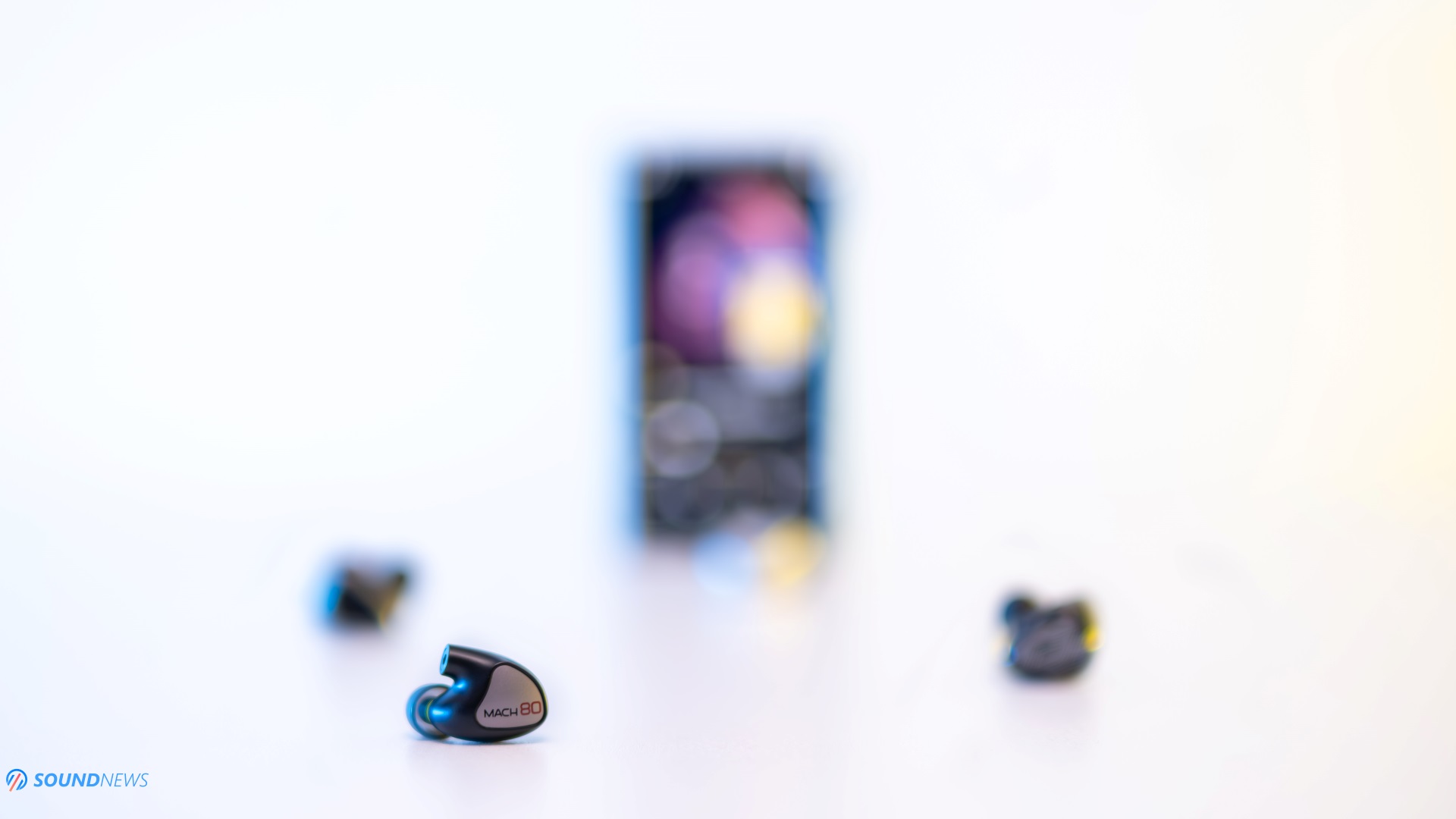
My Conclusion
Some IEM makers try to overexcite us, throwing so many words at us when describing their latest creations. Marketing materials usually repeat words such as reference, studio-grade, balanced, and accurate, but in real-life scenarios, only a handful of units perform as such. After living with the best IEMs by Westone for more than three months, I realized that these words best describe their sound objectively and subjectively. I could finally retire the FiiO FX15, HiBy ZETA, and HiFiMan Svanar trio, as, simply put, the Westones were better in every single department, including measurements.
These can be fun and engaging on the right gear, but regardless of the source material, they always sounded resolving, airy, and decompressed, shrinking the gap between the sound of tiny IEMs and desktop-grade open-back headphones. Besides a gentle roll-off I have experienced in the upper midrange that removed some of the sweetness, I have nothing else to complain about their performance, instantly becoming my new go-to reference IEMs for the years to come. And if you’re already contemplating getting a unit, I have a small word of advice: please don’t judge them in the first hours of use. The sound will get better, and in time you’ll start appreciating the added resolution and tightness. When something’s pure-sounding right from the start, there’s nothing that needs to be addressed, mitigated, or changed.
If you need a comfortable IEM that can go with you anywhere, that offers crazy levels of technicalities and an unaltered tone and timbre, without going into the ridiculously overpriced territory, then I do recommend the Westone MACH 80.
At this point, I no longer find their plasticky shells to be a liability, but an asset if worry-free comfort is important to you. I no longer need to worry if these are properly inserted before going outside for a stroll, and even if they might fall, I’m sure their featherweight shell won’t get damaged.
Priced at $1,599, I acknowledge that some individuals might seek more affordable alternatives, and that’s understandable. Reference-grade IEMs are usually reserved for seasoned audiophiles with deeper pockets, and you can never put a price on the experience a few IEM manufacturers such as Westone have under their belts. These guys haven’t crafted IEMs since yesterday; they know their stuff, and let’s not forget that eight high-performance drivers per IEM and custom crossovers don’t go cheap nowadays, especially when you add a hard acrylic case and a crazy number of ear tips tailored for every ear size and age.

These tiny little things made a significant impression on me, and as a result, I’ll be overlooking some of their measurements, awarding them our highest honors. The Gold Award is well-deserved, and I’m looking forward to their next doings.
The MACH 80 was generously provided by Westone. You can acquire them from their international web store right here. If you decide to get a pair, please don’t hesitate to say hello and leave a comment below.
PROS:
- An excellent unboxing experience
- A wide selection of accessories is included
- The cable is lightweight but strong with zero microphonics
- Bar none comfort levels!
- Easy to drive, but they will still crave a nicer source
- Outstanding stereo separation, akin to using mid-sized open-back headphones
- Excellent transient response, pace, rhythm, and timing
- Cohesive sounding even on crowded tracks
- Linear and honest sounding at all times
- Extended treble without becoming harsh or metallic
- Highly detailed and transparent-sounding
CONS:
- A 3.5mm only detachable cable is provided. If you need a different connector, you’ll need to buy a new cable
- A proprietary nozzle head limits your ear tip hunt.
- The upper midrange could use a helping hand in boosting that energy
ASSOCIATED EQUIPMENT:
- Digital Transport / Roon Server/ Streamer: Rockna Wavedream NET 4 Tb
- Network Switch: Ansuz PowerSwitch D3
- DACs: Rockna Wavedream Signature XLR, LAiV Harmony
- Headphone Amplifiers: HiFiMan PRELUDE, Ferrum OOR & HYPSOS, Soloist Voyager, Trafomatic Primavera, Enleum AMP-23R
- DAPs: Shanling M5 Ultra, Onix XM5, HiBy R8 II
- IEMs; Westone MACH80, HiBy ZETA, HiFiMan Svanar & others
- Full-sized headphones: HiFiMan Susvara, T+A Solitaire P & many others (15+)
- Interconnects: Crystal Cable Art Series Monet XLR (X2)
- Power Cables: Crystal Cable Art Series Monet (X4)
- Balanced Isolation Power Conditioners: KECES IQPR-1500 (stereo setup), PLiXiR Elite BAC 1500 (headphone setup)
